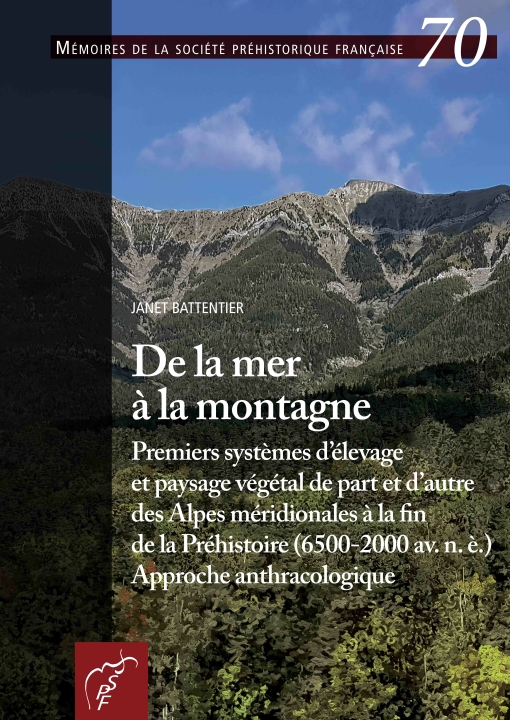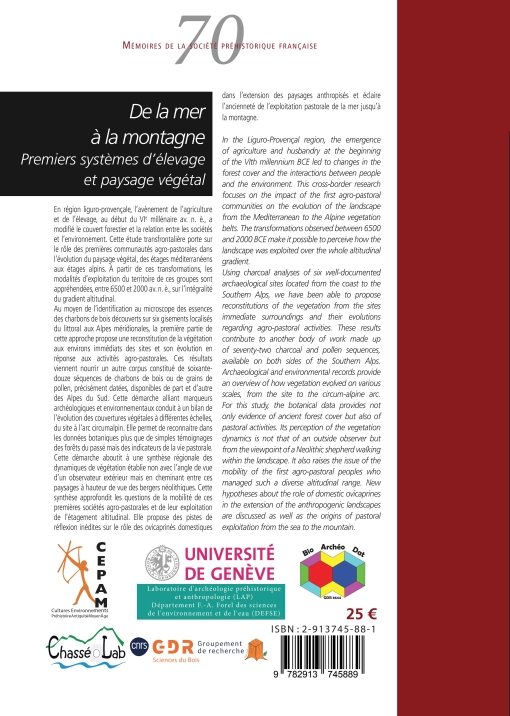- La SPF
- Réunions
- Le Bulletin de la SPF
- Organisation et comité de rédaction
- Comité de lecture (2020-2025)
- Ligne éditoriale et consignes BSPF
- Données supplémentaires
- Annoncer dans le Bulletin de la SPF
- Séances de la SPF (suppléments)
- Bulletin de la SPF 2025, tome 122
- Bulletin de la SPF 2024, tome 121
- Bulletin de la SPF 2023, tome 120
- Bulletin de la SPF 2022, tome 119
- Archives BSPF 1904-2021 en accès libre
- Publications
- Newsletter
- Boutique
Prix : 25,00 €TTC
M70 (2022) - De la mer a la montagne. Premiers systèmes d'élevage et paysage végétal de part et d'autre des Alpes méridionales. la fin de la Préhistoire (6500-2000 av. n. è.) - Approche anthracologique de Janet BATTENTIER
Résumé :
En région liguro-provençale, l'avènement de l'agriculture et de l'élevage (début du VIe millénaire BCE) a modifié le couvert forestier et la relation entre les sociétés et le milieu qu'elles exploitent. L'analyse anthracologique de six sites archéologiques répartis du littoral jusqu'à 1000 m d'altitude et occupés entre la fin du Mésolithique (Castelnovien) et le Néolithique final (ca 6500-2000 BCE) précisent les modalités de ces évolutions, venant combler les lacunes chronologiques, géographiques et sitologiques d'un large corpus préexistant (78 séquences, anthracologiques et polliniques, en contexte archéologique ou naturel).
De part et d'autre de l'arc liguro-provençal, des dynamiques de végétation relativement similaires se traduisent de façon variable en termes de paysages. Au Castelnovien et à l'Impressa (6500-5600/5400 BCE), les futaies denses et diversifiées prédominent sur un large gradient altitudinal. Dans les basses terres et en altitude, les milieux ouverts, sans doute plus propices aux activités de subsistance (chasse, pastoralisme, agriculture) semblent toutefois préférés par les derniers mésolithiques et les premiers néolithiques.
A partir de la seconde moitié du VIe millénaire BCE, de la méditerranée aux étages alpins, les premières atteintes anthropiques sur le couvert forestier favorisent l'augmentation discrète des végétaux tolérant l'ouverture du milieu et le recul des taxons plus sensibles. Bien que ce processus se renforce progressivement, à toutes les altitudes, sur fond de diversification de l'exploitation du territoire, des séquences anthracologiques attestent du maintien des chênaies caducifoliées dans l'arrière-pays jusqu'au Néolithique final. Ainsi, au fil du Néolithique, l'ouverture anthropique du milieu se déploie sous forme d'éclaircies, de plus en plus répandues mais qui demeurent localisées. Le recul des formations forestières, la baisse de leur diversité et l'essor des taxons de milieux ouverts témoignent directement d'un changement des paysages débuté sans doute en amont, par la modification de l'apparence des forêts (taillis vs futaies). Ainsi, le paysage végétal actuel trouve sa genèse dans les pratiques néolithiques.
Mots-clés : Néolithique, paysage, anthracologie, dynamique de végétation, pastoralisme, Holocène, Méditerranée nord-occidentale.
Abstract:
FROM THE SEA TO THE MOUNTAIN: INITIAL FARMING SYSTEMS AND VEGETAL LANDSCAPE ON EACH SIDE OF THE SOUTHERN ALPS AT THE END OF THE PREHISTORY (6500-2000 CAL. BCE) ANTHRACOLOGICAL CONTRIBUTION
The Liguro-Provençal region extends from the Mediterranean Sea to the Southern Alps and from the Northern Apennines to the Rhone River. In this coastal and mountainous region, the emergence and the development of agropastoral subsistence economies, at the beginning of the 6th millennium BCE, led to changes as regards interactions between these societies and the landscapes they exploited as well as the composition and the physiognomy of the pre existing forest cover. However, although anthropogenic modifications regarding the composition of the plant cover are largely known, the vegetation dynamic needs to be specified at the regional scale. Furthermore, characterising the impacts of these modifications on the physiognomy of the landscape and on settlement strategies still is a debate. We therefore investigated the modalities regarding the evolution of the landscape's vegetation and the diversity of the territories suitable for agropastoral purposes according to a comprehensive altitudinal gradient. These data made it possible to document the spatial organisation of the Neolithic groups from a new perspective and to look at the process of territorial appropriation, from the sea to the mountains. The present study specifies the modalities of these socio-ecological transformations based on charcoal analyses of six well???documented archaeological sites located in southern-eastern France that were occupied from the end of the Mesolithic (Castelnovian) to the Late Neolithic (6500-2000 cal. BCE). It concerns sites located in various environments ranging from the coast to regions reaching 1000 m a.s.l: Font-aux-Pigeons (Châteauneuf-les-Martigues, Bouches-du-Rhône), the Pendimoun shelter (Castellar, Alpes-Maritimes), «RD 560/RD 28 déviation de St-Maximin» and «le Clos de Roques/Route de Barjols» (Saint-Maximin-la-Sainte-Baume, Var), the Pertus II cave (Méailles, Alpes-de-Haute-Provence), Ponteau (Martigues, Bouches-du-Rhône), and Limon-Raspail (Bédoin, Vaucluse). These temporary and semi-permanent occupations could be precisely radiocarbon dated. As a result, this research has filled previously existing gaps regarding chronological, geographical and settlement patterns. Examination of a large body of charcoal and pollen data (78 sequences from archaeological and natural contexts) makes it possible to propose nuanced scenarios on landscape evolution across the Liguro-Provençal region and their relation to human practices. The key contribution of this body of data relies on the combination of sequences from archaeological sites and of sequences from natural contexts. Thanks to the recently improved chronological setting, it enables us to link, spatially and temporally, the environmental data and the socio-economic data related to the different populations that succeeded each other during the Neolithic. An ecological and phytosociological approach of the archaeobotanical data makes it possible to characterise the vegetation dynamic at various scales (from the site scale to the micro-regional and regional scales), focussing on the temporalities of the processes and on the variation of the landscapes, as well as on their effects on the organisation of the Mesolithic and Neolithic societies.
This diachronic and multiscale reconstruction reveals that while vegetation dynamics seem relatively synchronous across the Liguro-Provençal region, their translations in terms of composition and physiognomy of the landscapes are more variable. During the Castelnovian and Impressa periods (6500-5600/5400 cal. BCE), besides the predominance of forest taxa such as deciduous oak (Quercus deciduous), elm (Ulmus sp.), and lime (Tilia sp.), we highlighted the expansion of fir (Abies sp.), which supports the importance of dense, diversified and sub-mature forests, on a broad altitudinal gradient. Open landscapes (characterised by evergreen taxa and light-demanding conifers) also prevailed in the lowlands and at high altitudes. These open landscapes appear to have been more attractive for settlement than fir forests, for both, Mesolithic hunter-gatherers and Early Neolithic farmers, maybe because they are more favourable for the main subsistence activities of these groups (hunting, farming, pastoralism). From the second half of the 6th millennium BCE on, there was a slight rise in plant-types that are more competitive in case of an opening up of the canopy and a decrease of taxa that are more sensitive to open conditions (mainly fir and deciduous oak) as a response to the first anthropogenic disturbances of the forest cover. Depending on the vegetation belt, this benefited mainly to buckthorn and/or phillyrea (Phillyrea sp./Rhamnus alaternus), evergreen oak (Quercus sempervirent), box-tree (Buxus sempervirens) and later, in the highlands, beech (Fagus sylvatica) and spruce (Picea abies) as the opening up of the forests and their replacement by more disturbance-adapted formations growing in the form of coppices increased through time. This process unfolded concomitantly with a diversification of the territories (lowland to upland) and the wood resources exploited by human populations. A staged exploitation of the environment developed in concordance with the increase of anthropogenic pressures related to the expansion of agropastoral systems. However, anthracological sequences from sites such as Limon-Raspail and Saint-Maximin-la-Sainte-Baume provide evidence of the maintenance of deciduous oak forests in the hinterland until the Late Neolithic. Thus, although the thinning of the forest cover spread progressively over the course of the Neolithic, it seems to have remained spatially restricted to rather limited areas.
The linking of different types of sequences in the different microregions makes it possible to gain insights into the vegetal landscape around and between the sites, in five development stages (stage 1: steppe formation; stage 2: forest optimum; stage 3: anthropogenic
opening of forest cover; stage 4: predominance of open formations;
stage 5: growth of the forest cover). Although the phasingis valid for the entire area, its expression in terms of vegetation dynamics proved to be polymorphic. Depending on the areas of the Liguro-Provençal region, the taxa that participate to each stage of the vegetation dynamic may vary. Moreover, the trend towards an opening up of the canopy is neither linear nor unidirectional since it depends on the cycles of decline and recovery of the economic activities. For example, during the Late Neolithic in the lowlands, pre-forest taxa often develop in under-exploited lands, resulting in an increasingly mosaic-like landscape. At a regional scale, this evolution appears to be arrhythmic, since around some sites the vegetation evolves directly from dense forests to widespread open environments due to drastic anthropogenic changes.
Furthermore, we propose that the trees habit, and therefore the appearance of the landscape (e.g. high forest vs. coppices) could have been modified by humans long before the changes in the vegetal composition became strong enough to be detected by pollen or charcoal analyses.
Changes in the vegetal landscape concern a large altitudinal range. Thus, we questioned the origin of the staged exploitationof the territory and tried to identify what triggered theconquest of the highlands. Field data concerning the behaviour of modern caprine herds shed a new light on the paleoeconomicand paleoenvironmental indicators of the staged land exploitation.
The hypothesis can be advanced that the 'climbing' behaviour of grazing herds together with the exploratory and independent nature of goats may have been one of the factors explaining early extensive exploration of the uplands by the first agropastoralists who settled on the coast. A holistic approach is necessary to discuss issues such as pastoral mobility. Obviously, archaeological and paleoenvironmental indicators are needed on a large altitudinal range, but the input of ethological data also contributed to feed the debate.
Keywords: Neolithic, landscape, charcoal analysis, vegetation dynamic, pastoralism, Holocene, north-western Mediterranean.
Société préhistorique française, 2022, 144 pages, 25 ? - ISBN 2-913745-88-1
(EAN : 9782913745889) - Ref : M70
(Mémoire 70)
Stock disponible : 156
Autres articles de "MÉMOIRES de la SPF"
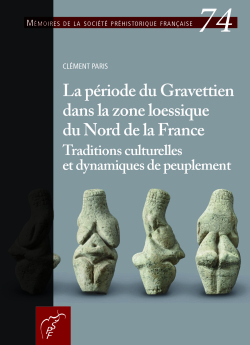
M74 (2024) - La période du Gravettien dans la zone loessique du Nord de la France : traditions culturelles et dynamiques de peuplement.
"La période du Gravettien dans la zone loessique du Nord de la France. Traditions culturelles et dynamiques de peuplement"
Par Clément Paris
Ce travail a pour origine l'étude et l'interprétation de gisements gravettiens. Jusqu'ici, cette période était mal connue en France septentrionale (Hauts-de-France) alors que la couverture de loess présentait des potentialités pour la conservation des gisements et les données paléoenvironnementales.
Le corpus étudié comprend dix gisements au total. Ils sont d'inégale valeur, avec des sites de premier ordre et d'autres qualifiés de complémentaires. L'étude de l'industrie lithique constitue la base de ce travail. Elle est appuyée par les données chronologiques, stratigraphiques voire palethnographiques pour répondre à deux problématiques sur les traditions culturelles et la dynamique de peuplement de cette région périglaciaire.
Trois traditions ont été distinguées. La plus ancienne est datée vers 33-32 ka cal. BP avec des occupations de courtes durées. Nous proposons de les rapprocher du Maisièrien. La seconde tradition suggère un rapprochement avec un Gravettien ancien évolué vers 31 ka cal. BP. Enfin, le Gravettien récent-final, le mieux représentée, prend place autour de 27,5 ka cal. BP.
Le nombre réduit de traditions, par rapport à la périodisation actuelle du Gravettien, a été le point de départ d'une réflexion sur la représentation des gisements en France septentrionale. Plusieurs facteurs semblent limiter la découverte des gisements, mais ils n'expliquent pas l'absence de certaines traditions gravettiennes. La convergence de données archéologiques et paléoenvironnementales, en revanche, oriente vers une occupation discontinue de la région, en relation avec les courtes phases d'amélioration climatique et la présence de biodiversité.
The present work is based on the study and interpretation of Gravettian sites. This period is not well known in Northern France (Hauts-de-France) to date, although the loess cover in this region potentially provided reasonable conditions for the preservation of sites and palaeoenvironmental data.
The corpus under study is comprised of a total of ten sites. These are disparate sites and they include main sites as well as others that could be described as complementary sites. The study of the lithic series is supported by chronological, stratigraphic and even palethnographic data in order to address two main issues: cultural traditions and settlement dynamics in this periglacial region.
It was possible to identify three cultural traditions. The earliest one is dated to 33-32 ka cal. BP and includes short-term occupations, which are assigned to the Maisierian. The second tradition can be attributed to the early evolved Gravettian, dated to 31 ka cal. BP. The third tradition, which is assigned to the late-final Gravettian, is the best represented and was established around 27.5 ka cal. BP.
The limited number of traditions compared to the current periodisation of the Gravettian gave rise to reflections as to the representativeness of the sites in Northern France. Several factors seem to hinder the discovery of sites, but this alone does not explain the absence of certain Gravettian traditions. However, the combination of archaeological and palaeoenvironmental data indicates discontinuous settlement in the region, in relationship along with short phases of climate amelioration and the presence of biodiversity.
Société préhistorique française, 2024, (Mémoire 74), 234 pages, 30 ? - ISBN : 2-913745-95-4 (EAN : 9782913745957)
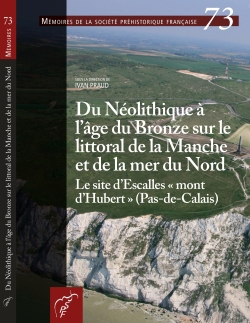
M73 (2024) - Du Néolithique à lâge du Bronze sur le littoral de la Manche et de la mer du Nord : le site dEscalles « mont dHubert » (Pas-de-Calais) dir. Ivan Praud
"Du Néolithique à l'âge du Bronze sur le littoral de la Manche et de la mer du Nord.
Le site d'Escalles « mont d'Hubert » (Pas-de-Calais)"
Publication dirigée et coordonnée par Ivan PRAUD.
Résumé :
Le site est implanté au sommet du mont d'Hubert (Escalles, Pas-de-Calais), à moins d'un kilomètre en retrait du cap Blanc Nez, qui forme la retombée crayeuse nord-occidentale de l'Artois. Depuis les hauteurs du mont d'Hubert, la vue enveloppe sans contrainte les paysages de la plaine maritime, du détroit du Pas-de-Calais et du sud-est de l'Angleterre, des falaises en grès du cap Gris-Nez. Ce panorama exerce, encore aujourd'hui, une fascination pour un milieu naturel où plusieurs formes paysagères se rencontrent et dessinent les contours de territoires aux qualités géologiques variées. Occupé du Néolithique moyen I à la fin de l'âge du Bronze, l'installation principale concerne une enceinte à fossés interrompus datée du Néolithique moyen 2. Elle se caractérise par le creusement de plusieurs segments enserrant un espace interne estimé à 4,5 ha. La diversité et les quantités de vestiges collectées lors de cette fouille sont impressionnantes associant au sein des mêmes contextes de rejets de la faune, du lithique, des ossements humains, de la céramique et des coquilles marines. Les comblements des différents fossés ont été abordés par une fouille fine. Cette stratégie a servi de base à l'étude des mobiliers et à la campagne de mesures radiocarbone ouvrant de nouvelles perspectives sur le rythme d'occupation du site. Aux activités traditionnellement identifiées, la présence, la répartition et la détermination des restes humains désarticulés, découpés et mêlés aux rejets alimentent la réflexion sur la fonction de ce gisement et des pratiques qui s'y sont déroulées. La relation Homme-Animal mérite aussi que l'on s'y attarde plus longuement en comparant le traitement des ossements humains et animaux (découpe, fracturation, exposition au feu...) afin de comprendre les rapports qui régissent ces événements et leurs rôles symboliques au sein de ces sociétés. Enfin, comment ne pas entrer dans le débat qui intéresse les chercheurs britanniques à propos de la néolithisation de la Grande-Bretagne, tant il apparaît évident que la position géographique et la datation de l'enceinte du mont d'Hubert suggèrent qu'elle a pu jouer un rôle dans la dernière colonisation néolithique de l'Europe notamment en établissant un contact avec les dernières communautés mésolithiques à la transition des Ve et IVe millénaire avant notre ère. A l'appui de cette hypothèse, des comparaisons sur les données matérielles et paléogénomiques sont intégrées à cette monographie.
Société préhistorique française, 2024, (Mémoire 73), 532 pages, 50 ?, ISBN : 2-913745-94-6 (EAN 9782913745940)
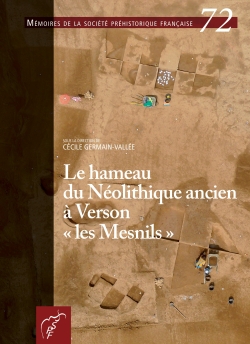
M72 (2023) - Le hameau du Néolithique ancien à Verson "les Mesnils" sous la direction de Cécile Germain-Vallée
Le hameau du Néolithique ancien à Verson « les Mesnils
sous la direction de Cécile GERMAIN-VALLÉE
Le site néolithique ancien de Verson « les Mesnils » est situé dans la Plaine de Caen (Calvados), en Normandie occidentale. Il a été fouillé lors d'une opération d'archéologie préventive conduite en 2012, qui a permis pour la première fois dans la région, d'étudier un hameau de l'étape moyenne de la culture de Blicquy/Villeneuve-Saint-Germain (BVSG). Formé de cinq maisons, il a été occupé en trois phases entre 5010 et 4830 av. notre ère, soit sur une durée d'environ 180 ans. A l'instar des sites d'habitat régionaux de cette période, il est localisé en contexte de plateau et implanté sur des pédo-sédiments d'origine loessique, ce qui a limité sa conservation. Les vestiges rencontrés se composent de plusieurs séries de grandes fosses, vingt-huit au total, dont l'organisation spatiale renvoie clairement à celles de fosses latérales des maisons de tradition danubienne, bien que les trous d'ancrage des poteaux ne soient pas lisibles. Les remplissages de ces structures ont livré un mobilier à vocation domestique dans des quantités et un état de conservation remarquables et inédits pour la Normandie occidentale. Leur analyse livre de nombreuses données sur la culture matérielle encore peu renseignée des néolithiques BVSG de cette partie de l'ouest de France. Les résultats de ces études combinées aux analyses menées sur les comblements de ces fosses (stratigraphique, micromorphologie et macrorestes végétaux), ont par ailleurs permis une étude de la nature et de la distribution des activités domestiques au sein des unités d'habitation de ce hameau. Cette répartition est analogue à celles généralement observées sur les sites dont des plans des bâtiments sont conservés. De nombreuses informations sur l'usage des fosses latérales ont aussi été obtenues grâce aux analyses. Elles indiquent qu'elles font partie intégrante du fonctionnement des maisons danubiennes et certaines pourraient aussi avoir des utilisations spécifiques, tandis que la plupart présente des traces de curage et de piétinements indiquant une probable gestion des déchets par les habitants du hameau. L'environnement et son exploitation par les néolithiques est une autre question qui a pu aussi être abordée par ces études.
Finalement, au regard de la forme de leur habitat et des vestiges mobiliers, en particulier des deux marqueurs de la culture BVSG que sont les lames en silex et les parures, l'analyse du site révèle que les néolithiques de Verson « les Mesnils » entretenaient de nombreux liens avec d'autres populations de la sphère BVSG. Ils pourraient même avoir joué un rôle dans la diffusion de ces objets.
The Early Neolithic site of Verson « Les Mesnils » was the object of a pre-development excavation carried out in 2012 on the Caen plain (Calvados), in western Normandy. We were able to study a small settlement dating to the middle phase of the Bliquy/Villeneuve-Saint-Germain culture (BVSG) for the first time in the region. It was composed of five houses occupied for a duration of about 180 years between 5010 and 4830 B.C, in three different phases. As is the case for corresponding habitat sites in the region, it is situated in a plateau context, implanted on pedosediments of loessic origin, which has limited it's conservation. The features consist of twenty eight large pits spatially organised in several series, clearly corresponding to the lateral pits of long houses of Danubian tradition, although post holes were no longer visible. The fill of these pits yielded abundant, well preserved domestic artefacts, some unprecedented, quite remarkable for western Normandy. Their study has provided data on the hitherto poorly documented material culture of the BVSG Neolithic peoples in this part of Western France. The results, combined with those of analyses carried out on the pit fills (stratigraphy, micromorphology, macrobotanical remains), has also enabled us to examine the nature and the spatial organisation of domestic activities within the dwelling units of this hamlet. The distribution pattern corresponds to those usually observed on sites for which the building plans are preserved. A lot of information on the use of the pits have been gleaned, showing that they were an integral part of the daily use of the danubian houses. Some of them may have had specific functions, whereas others show evidence of having been cleaned out and trampling, pointing to their probable use for waste mangement by the people living there. The environment and how Neolithic peoples made use of it is another question we were able to approach.
All in all, taking into account the form of the habitat and the artefacts discovered, particularly the two BVSG cultural markers, flint blades and personal ornaments, the site study reveals many links between the inhabitants at Verson « Les Mesnils » and other populations within the BVSG sphere. They may even have played a role in the diffusion of these objects.
Société préhistorique française - 308 pages, 35 euros. ISBN : 2-913745-91-1 (EAN : 9782913745919)
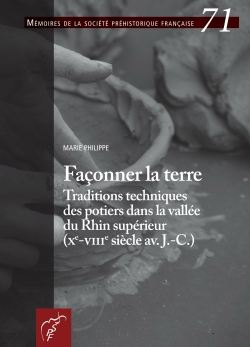
M71 (2023) - Façonner la terre. Traditions techniques des potiers dans la vallée du Rhin supérieur (Xe-VIIIe siècle av. J.-C.) de Marie Philippe
Façonner la terre. Traditions techniques des potiers dans la vallée du Rhin supérieur (Xe-VIIIe siècle av. J.-C.) de Marie PHILIPPE
Résumé
Comment les céramiques de l'âge du Bronze étaient-elles fabriquées ? L'étude technologique menée sur seize habitats et trois nécropoles de la vallée du Rhin supérieur et environs proches, occupés entre le Xe et le VIIIe siècle av. J.-C, révèle l'incroyable variabilité des chaînes opératoires mises en oeuvre. Les macrotraces techniques observées sur les 829 céramiques du corpus sont abondamment illustrées, et leur interprétation se fonde sur une synthèse critique de nombreux référentiels ethnographiques et expérimentaux.
La représentation des chaînes opératoires par des arborescences répond à une rigoureuse méthode de tri hiérarchique des données. Cette dernière permet de reconstituer de manière innovante les traditions techniques, héritées et transmises entre membres de communautés au fondement social et/ou spatial. Ces réseaux d'interactions, liés à l'apprentissage de l'artisanat potier, sont modélisés à partir de calculs de similarité entre assemblages archéologiques. L'identité sociale des potiers et potières est alors questionnée, en lien avec les style morpho-décoratifs de la vallée. La transmission des manières de faire démontre la persistance de ces groupes sociaux à travers les étapes de la chronologie relative.
Toutefois, l'affiliation identitaire des producteurs ne suffit pas à expliquer la variabilité des chaînes opératoires. Tout d'abord, le déplacement de produits-finis est démontré sur des distances variables par l'observation des pâtes céramiques. Ensuite, les tests d'indépendance statistique révèlent que l'emploi de certaines techniques entraînant des avantages utilitaires (imperméabilisation, résistance aux chocs thermiques, etc.) est préférentiellement associé à certaines formes de récipients. Certains comportements techniques récurrents sont donc conditionnés par le produit-fini recherché, et cela amène à envisager la fonction à laquelle peuvent être destinés les vases (différente de leur utilisation réelle). Enfin, l'analyse de la co-représentation des traditions techniques par site introduit les notions de complémentarité et de concurrence des productions, mais aussi la question d'une spécialisation de cet artisanat à l'aube de l'âge du Fer.
Sur la base de la détermination des techniques utilisées pour fabriquer les céramiques, à travers une dense réflexion méthodologique et un raisonnement interprétatif échelonné sur plusieurs plans successifs et croisés, c'est donc tout le contexte socio-économique entourant les potiers et potières de la fin de l'âge du Bronze qui est investigué dans cet ouvrage.
Abstract
How was pottery made during the Bronze Age? The technological ceramic study carried out on 16 habitation and 3 funerary sites of the upper Rhine Valley and its surroundings, which date from the 10th to the 8th centuries B.C., reveals an incredible variety among chaînes opératoires. Macrotraces observed on 829 ceramics are abundantly illustrated, and their interpretation is based on a review of numerous ethnographic and experimental reference papers.
The chaînes opératoires are depicted by trees following a rigorous method of hierarchical data clustering. This allows technical traditions, which are inherited and transmitted among members of social- and spatial-based communities, to be reconstructed in an innovative manner. These networks of interplays, which are linked to craft-learning, are modeled using similarity measures between ceramics assemblages. Pottery styles, determined by types of shapes and decorations, can then give insight into the potters' social identities. The transmission of technical traditions reveals that these social groups persisted through chronological phases.
However, relying solely on potters' social membership is insufficient when it comes to explaining the presence of such diversity in chaînes opératoires. First, paste examination proves that finished products were moved across various distances. Then, statistical tests of independence indicate that some techniques producing utilitarian advantages (waterproofing, thermal shock resistance...) are preferentially used to make some shapes of containers. Thus, recurrent technical behaviors are conditioned by which finished product is wanted, leading to discussions concerning the intended function of the ceramics (which is different from their actual use). Finally, the co-representation of several technical traditions within ceramic assemblages introduces the concepts of complementary and competing productions, as well as the question of pottery as a specialized craft at the dawn of the Iron Age.
By determining the techniques used to produce ceramics, through thorough methodological consideration and an interpretive reasoning following successive and crossed frames, this book investigates the entire social and economical context surrounding potters of the Late Bronze Age.
Société préhistorique française, 2023, (Mémoire 71), 256 pages, 30 ?, ISBN : 2-913745-90-3 (EAN 9782913745902)
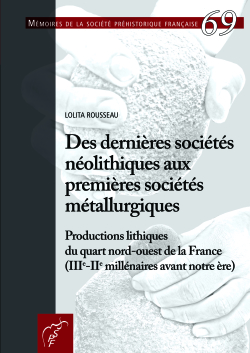
M69 (2022) - Des dernières sociétés néolithiques aux premières sociétés métallurgiques Productions lithiques du quart nord-ouest de la France (IIIe-IIe millénaires avant notre ère) de Lolita Rousseau
Des dernières sociétés néolithiques aux premières sociétés métallurgiques : Productions lithiques du quart nord-ouest de la France (IIIe-IIe millénaires avant notre ère) de Lolita Rousseau
Cet ouvrage est le résultat d'un travail doctoral soutenu en 2015 à l'Université de Nantes. Il porte sur l'étude de l'ensemble des assemblages lithiques (taillés, polies et macrolithiques) d'une période charnière correspondant au passage théorique d'un « âge de la Pierre » à un « âge des Métaux », dans le quart nord-ouest de la France. Si cette subdivision des âges pouvait laisser penser que la pierre a cessé d'être utilisée au-delà du Néolithique, entrainant un manque d'intérêt pour ces artefacts, notre travail a permis de montrer l'existence d'une telle production durant tout l'âge du Bronze (culture campaniforme comprise), puisque ce sont plus de 570 entités archéologiques, tous contextes confondus, qui ont été inventoriées. Cette recherche est fondée sur une analyse des matières premières et des gisements associés, sur les études typo-technologiques d'une vingtaine de séries lithiques, ainsi que sur les données bibliographiques issues de cet important corpus. Cela a permis d'atteindre trois objectifs principaux. Le premier a consisté à saisir les modalités d'acquisition et de gestion des ressources, tout en prenant en compte l'impact de l'environnement géologique et géomorphologique sur les choix techno-économiques des différents groupes humains. Le deuxième était de caractériser les économies de fabrication et de consommation des objets, afin de cerner une partie des activités pratiquées sur les sites, et ainsi compléter nos connaissances sur les modes de vie de ces populations. Enfin, le troisième a permis d'aborder la marginalisation progressive du mobilier lithique au cours du IIe millénaire tout en proposant des éléments de réponse quant à ce phénomène. Bien que ces productions perdent progressivement leur place majeure au sein du schème global des sociétés de l'âge de Bronze, cette composante matérielle ne peut plus, aujourd'hui, être ignorée en raison de son caractère informatif et complémentaire pour la compréhension de ces dernières.
This book is the result of a doctoral thesis defended in 2015 at the University of Nantes. It deals with the study of all the lithic industries (knapped flint, polished axes, ornaments and ground stone tools) known for a pivotal period which corresponds to the theoretical transition from a "Stone Age" to a "Metal Age", in the North-western part of France. If such a subdivision of ages may suggest that stone was not any longer in use beyond the Neolithic period, our work shows the existence of such a production throughout the whole Bronze Age (including the Bell Beaker Culture). Indeed, we drew up an inventory of more than 570 archaeological entities; all contexts combine. We based this research on the analysis of raw materials, on the typo-technological study of some twenty lithic series, as well as on the collecting of the bibliographic data resulting from this important corpus. We have achieved three main goals. The first one was to understand the acquisition modes and management of resources with taking into account the impact of geological and geomorphological environment on techno-economic choices of different human groups. The second objective was to characterise manufacturing and consumption economies of artefacts. This made it possible to identify some of the activities undertaken on the settlements, thus enhancing our knowledge regarding the lifestyles of these populations. Finally, the last objective helped understanding the progressive marginalisation of lithic productions during the second millennium BC while proposing some answers to this phenomenon. Although these productions gradually lose their major place within the overall scheme of Bronze Age societies, this component can no longer be ignored given its informative and complementary nature in the understanding of the latter.
Société préhistorique française, 2022, 244 pages, 30 ?. ISBN : 2-913745-87-3 (EAN : 9782913745872) - Ref : M69
(Mémoire 69)
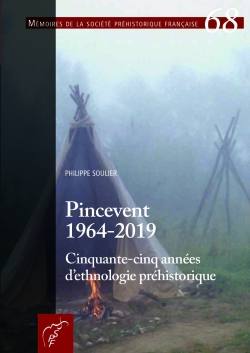
M68 (2021) - Pincevent (1964-2019). Cinquante-cinq années d'ethnologie préhistorique, de Philippe Soulier
Pincevent (1964-2019). Cinquante-cinq années d'ethnologie préhistorique de Philippe Soulier
Résumé :
Pincevent est un site magdalénien de Seine-et-Marne, fouillé d'abord sous la direction d'André Leroi-Gourhan pendant près de vingt ans, puis par ses successeurs sans discontinuer. De ces 55 années de recherches (1964-2019), retracées ici à travers les rapports annuels et des centaines de publications, dont quelques monographies qui ont fait date, est tirée une relation centrée sur l'adaptation puis l'évolution des méthodes de fouilles, sur le déplacement progressif des objectifs, sur leurs extensions et les liens de plus en plus imbriqués de leurs modalités dans une perspective unique dès l'origine : l'ethnologie préhistorique. En effet, Pincevent est, pour André Leroi-Gourhan et dès sa découverte, le terrain idéal pour développer son ambition de fouille expérimentale, et tenter d'approcher ainsi le quotidien de la vie des hommes de la préhistoire. Commencé comme une opération de sauvetage, le chantier est très vite devenu le lieu d'une expérience pérenne dont les retombées méthodologiques se sont ensuite répandues dans l'ensemble de la profession. Mais, au-delà du suivi des avancées méthodologiques - dont celles de fouille et d'analyses du matériel lithique, des foyers ou de l'étude de la faune - nous avons voulu en suivre les rapports avec le concept même d'ethnologie préhistorique. Pour cela, à la suite des travaux et écrits de Leroi-Gourhan antérieurs à 1964 (lorsque lui et son équipe fouillaient les grottes d'Arcy-sur-Cure ou l'hypogée des Mournouards), sont pris à témoin aussi bien les propos, tant théoriques que pragmatiques et descriptifs des fouilleurs eux-mêmes, que les réflexions, commentaires, voire critiques que les autres préhistoriens ou ethnologues ont pu faire depuis un demi-siècle sur ces travaux qui constituent une référence aujourd'hui largement partagée. Que ce soit pour les méthodes de fouille ou d'interprétation ethnologique des vestiges ou des structures mises au jour, cet ouvrage se présente comme un socle pour les travaux et réflexions futurs.
Abstract :
Pincevent, one of the most significant prehistory archaeological sites in the world, is 84 km south-east of Paris in the Seine-et-Marne Department. The area is rich in evidence of life in the Magdalenian period around 12,000 years ago and was first excavated in 1964 by André Leroi-Gourhan. His work spanned nearly two decades and has continued in similar vein since his death in 1986.
Leroi-Gourhan was an innovator in bringing vibrancy to prehistory research that became a model for generations of archaeologists and anthropologists."I am looking for men and not stones" became his mantra. For him, Man's development progressed far beyond that of other species for two main reasons: the invention of tools and the use of symbols, including language.
Some 55 years of research (1964-2019), retraced here through annual reports, hundreds of publications and some landmark monographs, illustrate the evolution of excavation methods. Expanding the objectives of archaeological searches, combined with appreciation of their intertwined links, has provided a unique perspective: prehistoric ethnology.
For Leroi-Gourhan, Pincevent was ideal for developing his ambition of using excavation to show daily life. But, beyond monitoring advances in methodology"including analysis of lithic material and the study of fauna - we wanted to follow their relationship with the very concept of prehistoric ethnology.
We drew on Leroi-Gourhan's pre-Pincevent writings (when he excavated inter alia the caves of Arcy-sur-Cure), noting his theoretical and pragmatic observations, plus descriptions of the excavators themselves. An extra ingredient for this book came from half a century of thoughts, comments, even criticisms from other prehistorians or ethnologists of his widely shared public works. Hopefully these chapters will provide a comprehensive base for future prehistory work and reflections (English summary by Peter Grimsditch)
Société préhistorique française, 2021, 168 pages, 25 ?, ISBN : 2-913745-85-7 (EAN : 9782913745858) - Ref : M68
(Mémoire 68)
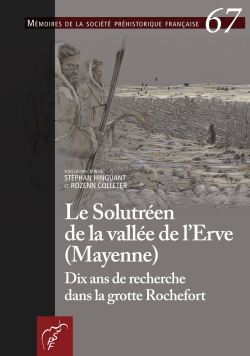
M67 (2020) - Le Solutréen de la vallée de l'Erve (Mayenne) Dix ans de recherche dans la grotte Rochefort Sous la direction de Stéphan Hinguant et Rozenn Colleter
Sous la direction de Stéphan Hinguant et Rozenn Colleter
Résumé :
La grotte Rochefort et dautres grottes de la vallée de l'Erve (Mayenne), témoignent d'occupations aux confins septentrionaux de l'aire d'extension du technocomplexe solutréen. Elles traduisent l'adaptation de ces groupes humains aux rudes conditions qui prévalaient durant le Dernier Maximum Glaciaire au nord de la Loire, entre 24 790 cal BP et 21 970 cal BP. Rarement observé dans de telles conditions, le Solutréen de la grotte Rochefort compose une entité archéologique dont létude suggère que la zone actuellement fouillée correspond à la périphérie dune ou plusieurs occupations. Dans un bilan sédimentaire moyen de 0,60 m d'épaisseur, le corpus mobilier compte plus de 8 000 objets dont environ 5 500 restes osseux, 2 000 pièces lithiques taillées et 300 plaquettes gravées.
Le site révèle une faune froide majoritaire, avec un spectre large où dominent le renne et le cheval. L'identification d'une microfaune froide caractéristique d'un biotope steppique, au côté de rongeurs inféodés à des milieux tempérés-humides, comme les restes végétaux carbonisés, confirment une restitution paléoenvironnementale qui peut s'apparenter à un refuge cryptique septentrional, véritable niche écologique durant le Dernier Maximum Glaciaire.
Toutes les pièces que compte l'assemblage lithique ont été apportées dans lenceinte de la grotte après débitage et sont en outre réalisées dans des matériaux exogènes, les gîtes primaires les plus proches du site se trouvant à 10 km. Associées à lindustrie osseuse, les longues lames régulières en grès lustré ou les proportions originales des « feuilles de laurier », composent un assemblage mobilier tout à fait singulier.
Sur le plan palethnologique enfin, le site révèle un art mobilier exceptionnel comptant de nombreuses plaquettes gravées portant des figures animales, anthropomorphes ou signes abstraits, corpus inédit en France pour la période, qui s'accompagne d'un art sur os et d'éléments de parure comprenant également des pièces uniques pour le Solutréen.
Abstract:
The Rochefort cave and more generally the whole of the cave sites of the Erve valley (Mayenne), testify to Solutrean occupations at the northern confines of the technocomplex extension area. It shows the adaptation of these groups of humans to the harsh conditions which prevailed during the Last Glacial Maximum north of the Loire, between 24790 cal BP and 21970 cal BP. Rarely observed under such conditions, the Solutrean of Rochefort cave finds itself to be an archaeological entity, offering all the advantages of an enclosed space. In a sediment with an average thickness of 0.60 m, a corpus of finds of more than 8000 objects made up of about 5500 bone remains, 2000 pieces of lithic industry and 300 engraved slabs, constitutes a unique ensemble.
The site reveals a cold fauna, with a large spectrum dominated by the reindeer and the horse. The identification of a cold microfauna characteristic of a steppe biotope, alongside rodents that live in temperate-humid environments, like the carbonised vegetal remains, confirms the palaeoenvironmental reconstruction thus envisaged for the "canyon", a cryptic refuge, a true ecological niche during the Last Glacial Maximum.
All the pieces which constitute the lithic assemblage had been brought into the enclosure of the cave and were worked in exogenous material. The closest primary source to the site is 10 km away. Associated with the bone industry, the long regular blades made from Eocene silicified sandstone or the original proportions of the "laurel leafs", make a corpus from the Rochefort cave a unique assemblage, totally unknown north of the Loire.
Finally, on the palethnological plan, the remarkable collection of numerous engraved slabs, unknown for the period in France, is accompanied by art on bones and personal ornaments, equally including pieces that are unique for the Solutrean.
Société préhistorique française, 2020, 442 pages, ISBN : 2-946745-82-2 (EAN : 9782913745827), 40 - réf : M67
(Mémoires, 67)
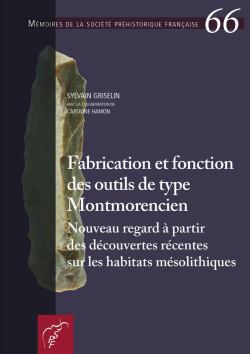
M66 - (2020) - Fabrication et fonction des outils de type montmorencien : nouveau regard à partir des découvertes récentes sur les habitats mésolithiques de Sylvain Griselin
de Sylvain Griselin avec la collaboration de Caroline Hamon
Les industries macrolithiques en grès, appelées montmorenciennes, ont depuis les premières découvertes à fin du xixe siècle interpellé les chercheurs. Les problématiques liées à leur utilisation et à leur attribution chronoculturelle sont toujours d'actualité, notamment suite à la découverte d'outils, nommés outils de type montmorencien, au sein de certains habitats mésolithiques.
C'est pour définir leur place au sein de la culture matérielle du Mésolithique que nous avons repris l'étude de ces outils trouvés en contexte d'habitat. Leur répartition géographique caractérise un « phénomène technique » d'ampleur régionale, voire suprarégionale au cours du premier Mésolithique. Les analyses montrent qu'il s'agit d'outils typés, employés sur une matière minérale dure et des tests expérimentaux nous orientent vers une utilisation comme retouchoirs pour la fracturation des lamelles par la technique du microburin.
On trouve des pièces similaires, morphologiquement et technologiquement, mais inachevées sur des sites « producteurs », c'est-à-dire principalement sur les sites montmorenciens sensu stricto et sur quelques habitats, alors que les modalités liées à leur diffusion à travers les territoires restent à définir. Nous avons aussi pu mettre en évidence sur certains sites montmorenciens sensu stricto des productions de haches, nous amenant à reconsidérer le Montmorencien qui ne désigne plus selon nous un faciès spécifique, en raison d'un mélange de productions tant mésolithiques que néolithiques.
Mots-clés : Mésolithique, Montmorencien, outil prismatique, macro-outillage, grès-quartzite, microburin.
Montmorencian sandstone macrolithic industries have aroused interest within the scientific community ever since the first finds at the end of the 19th century. Questions related to their use and chronocultural attribution are still relevant, especially following the discovery of specific tools (called Montmorencian-type tools) within some mesolithic campsites.
The aim of our study is to identify the role of the Montmorencian-type tools within the Mesolithic material culture. Their geographical distribution reveal a "technical phenomenon" of regional or even supra-regional scale during the first Mesolithic. Analyses show that they are standardised tools, used on hard mineral material. Experimental tests results are compatible with their use as retouchoirs for the process of knapping bladelets by the microburin technique.
Similar tools, sharing technological and morphological characteristics but unfinished, are found within the production sites i.e. Montmorencian sites, and some campsites. The modalities of the geographical diffusion of these specific tools has yet to be determined. Our work has also led to the identification of lithic artefacts related to axe productions in Montmorencian sites in the strict sense Therefore, in our opinion, Montmorencian should no longer designate specific sites as both Mesolithic and Neolithic populations are the authors of what appears to be mixed industries.
Keywords: Mesolithic, Montmorencian, prismatic tool, ground stone tool, quartzite, microburin
Société préhistorique française, 2020, 234 pages, ISBN : 2-913745-81-4 (EAN : 9782913745810), 30 ? - réf : M66

M65 - (2019) - La parure en métal de l'âge du Bronze moyen atlantique de Marilou Nordez
M65 - La parure en métal de l'âge du Bronze moyen atlantique
de Marilou Nordez
A compter du xve siècle avant notre ère en Europe atlantique, des ornements corporels en bronze ont été enfouis en très grand nombre, principalement en contexte de dépôts non funéraires. Les parures métalliques de France nord-occidentale sont au coeur de cette étude et sont également mises en perspective avec celles des régions voisines, à savoir le Sud de l'Angleterre, la moitié méridionale de la France et, plus ponctuellement, l'Europe du Nord. La prise en compte d'une aire géographique étendue a permis d'envisager différentes échelles et réseaux de production et de diffusion des bijoux en alliages à base de cuivre.
Un enjeu majeur de cet ouvrage est de préciser le concept de Bronze moyen atlantique grâce à l'examen typo-technologique et contextuel de la parure métallique. Certains aspects culturels, socio-économiques, techniques et symboliques ont pu être abordés très précisément par l???étude des parures métalliques, à la fois d'après l'analyse fine de leur morphologie et de leur décor, des traces de fabrication et d'utilisation, de leur contexte, des objets et structures associés, ainsi que de leurs modalités d'enfouissement. Outre l'élaboration d'une typologie renouvelée et l'affirmation de l'obsolescence de certains types de bracelets (Bignan) et d'épingles (Picardie), c'est aussi la démonstration de l'emploi généralisé de la technique de la fonte à la cire perdue dès le Bronze moyen, de pratiques d'enfouissement particulières et d'échanges à très longues distances qui peuvent être mentionnés comme principaux apports de cette publication.
En définitive, la parure en bronze s'avère être un excellent marqueur pour l'étude des sociétés de l'âge du Bronze moyen atlantique, dont cet ouvrage pluridisciplinaire contribue à préciser les cadres socio-économiques et techniques, la définition des entités géographiques et les subdivisions chronoculturelles.
From the 15th century BC onwards, a large number of bronze body ornaments were deposited beneath the ground in Atlantic Europe, mainly in the context of hoards. The metal ornaments of north-western France form the core of this study and are compared with those of neighbouring regions, namely the South of England, the southern half of France and, more occasionally, Northern Europe. By taking into account a wide geographical area, one can consider different scales and networks for the production and distribution of ornaments made from copper-based alloys.
A major goal of this book is to clarify the concept of the Atlantic Middle Bronze Age through the typo-technological and contextual analysis of metal ornaments. Their detailed study enables the exploration of a number of cultural, socio-economic, technical and symbolic aspects, in terms of morphology and decoration, traces of manufacture and use, depositional context and associated elements. In addition to the development of a renewed typology and the affirmation of the obsolescence of certain types of bracelets (Bignan) and pins (Picardy), the main results of this study are the demonstration of widespread use of lost-wax casting from the Middle Bronze Age onwards, as well as particular depositional practices and long-distance exchanges.
Ultimately, bronze ornaments are proving to be effective markers in the analysis of Atlantic Middle Bronze Age societies. This multidisciplinary study not only helps to clarify their socio-economic and technical framework, but also redefines geographical entities and chrono-cultural subdivisions.
Société préhistorique française, 2019, 404 pages, ISBN 2-913745-77-6 - EAN 9782913745773 - 30 ? - réf : M65
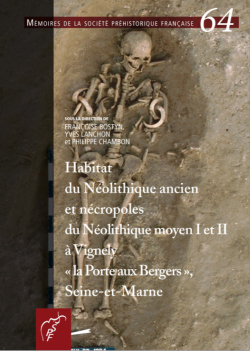
M64 - (2018) Habitat du Néolithique ancien et nécropoles du Néolithique moyen I et II à Vignely, « la Porte aux Bergers », Seine-et-Marne - Sous la direction de F. Bostyn, Y. Lanchon et P. Chambon
M64 - Habitat du Néolithique ancien et nécropoles du Néolithique moyen I et II à Vignely, « la Porte aux Bergers », Seine-et-Marne
Sous la direction de Françoise Bostyn, Yves Lanchon et Philippe Chambon
Le site de Vignely « la Porte aux Bergers » montre une pérennité d'occupation, domestique au Néolithique ancien puis funéraire à partir du Néolithique moyen. L'habitat est représenté par dix unités d'habitation dont quatre ont livré des plans de maisons trapézoïdales de type danubien, accompagnées de deux sépultures, mais les destructions anciennes ne permettent pas de connaitre l'étendue du village. Le mobilier céramique, relayé par des datations radiocarbone, permet de diviser l'occupation en quatre phases, depuis une phase ancienne rattachable au Rubané final du bassin de la Seine jusqu'à la phase finale du Blicquy-Villeneuve-Saint-Germain. Cette longue occupation, et nombre de caractères originaux dans la culture matérielle (part du silex crétacé, faible représentativité des activités artisanales dans le macro-outillage, importance des caprinés au BVSG final), lui confèrent une place particulière au sein de la basse vallée de la Marne. La nécropole, incomplète elle aussi, comprend vingt-six tombes dont vingt-deux, correspondant à trente-deux inhumés, sont attribuées au Cerny et quatre, correspondant à six individus, au Néolithique moyen II. En dépit de caractéristiques très semblables à Passy, Balloy ou Gron, l'absence de monuments démarque cet ensemble et contribue à la nécessaire déconstruction du système funéraire Cerny : les sépultures type « Balloy » sont présentes dès le début de la culture, la structuration avec sujets prééminents est indépendante des monuments... Bien que rare le mobilier associé aux sépultures souligne encore la place du monde sauvage dans les représentations : ours, auroch, loup et cerf sont utilisés dans l'outillage ou la parure. Première d'une série de découvertes similaires, un monument allongé comprenant deux sujets a été mis au jour pour le Néolithique moyen II. Cette période a aussi livré deux sépultures comprenant des haches polies, sans doute en lien avec la minière de Jablines « le Haut-Château ».
The site of Vignely "la Porte aux Bergers" shows a long-lived occupation, domestic in the Early Neolithic then funerary from the Middle Neolithic onwards. The settlement comprises ten house units of which four produced trapezoidal houseplans of Danubian type, accompanied by two graves, although the extent of the site is unknown due to early destruction. The pottery finds, together with radiocarbon dates, enable the occupation to be divided into four phases, from an early phase that can be assigned to final Seine basin Linear Pottery, right up to the last stage of Blicquy/Villeneuve-Saint-Germain. This long occupation and a number of original traits in the finds (high proportion of Cretaceous flint, low representation of craft activities in macrolithic tools, importance of caprines in the final BVSG) give the site a special position within the lower Marne valley. The cemetery, also incomplete, contains twenty-six graves of which twenty-two, corresponding to thirty-two individuals, are attributed to Cerny, and four, corresponding to six individuals, to Middle Neolithic II. Despite characteristics very similar to Passy, Balloy or Gron, the absence of Passy-type monuments distinguishes this group and contributes to the necessary deconstruction of the Cerny funerary system: "Balloy-type" graves are attested from the beginning of this culture and structuring with preeminent individuals is independent of monuments... Although rare, the finds associated with the graves still highlight representations of the wild world: bear, aurochs, wolf and red-deer are used for tools and ornaments. First of a series of similar discoveries, a long monument with two individuals was found for Middle Neolithic II. This period also produced two graves with polished axes, no doubt linked to the mine at Jablines "le Haut-Château".
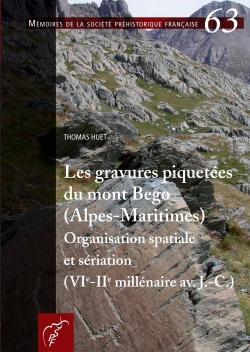
M63 - (2017) Les gravures piquetées du mont Bego (Alpes-Maritimes) Organisation spatiale et sériation (VIe-IIe millénaire av. J.-C.) - T. HUET
Les gravures piquetées du mont Bego (Alpes-Maritimes)
Organisation spatiale et sériation (VIe-IIe millénaire av. J.-C.)
Thomas HUET
Le site du mont Bego (Alpes-Maritimes), dit aussi « Vallée des Merveilles », rassemble l'une des principales concentrations d'art rupestre d'Europe occidentale. Le site compte quelque 36 000 gravures - dont 20 000 figuratives : corniformes, formes géométriques, armes et anthropomorphes - réalisées par piquetage sur environ 4 200 blocs et affleurements étagés entre 2000 m et 2700 m d'altitude. La datation et la signification de ces représentations restent encore largement débattues.
Les équipes dirigées par H. de Lumley, au terme d'un travail mené sur plus de quarante ans, ont relevé ces gravures et constitué un corpus qui tend aujourd'hui à l'exhaustivité. Accompagnant ces relevés, le positionnement des roches et les descriptions ont été enregistrés dans une base de données. L'étude de cette documentation dans un système d'information géographique (SIG) et au travers d'analyses statistiques, permet d'identifier des groupements significatifs de gravures. Des effets de sériation et de toposériation sont mis en évidence. Ces effets sont ensuite confrontés aux indices chronologiques apportés par les superpositions de gravures. Ces observations sont suffisamment convergentes pour proposer une périodisation des gravures piquetées. Les figures à franges, des anthropomorphes schématiques, semblent les plus anciennes (période 0), les hallebardes, les personnages et les corniformes naturalistes en forment la strate la plus récente (période 4). Les autres thèmes gravés se distribuent entre ces terminus.
A l'échelle des Alpes occidentales et méridionales, le site du mont Bego est l'un des premiers, au-dessus de 1700 m d'altitude, a être occupé saisonnièrement comme en attestent les découvertes in situ d'éléments appartenant au Cardial et au Chasséen (Néolithique ancien et moyen). Des études paléoenvironnementales révèlent également une précocité des indices d'activités pastorales qui semblent certaines dès le Campaniforme récent (Néolithique final) et le début de l'âge du Bronze. Malgré le manque de connexions directes entre le mobilier archéologique et l'art rupestre, la typologie des représentations d'armes, les périodes d'occupation du site et des comparaisons prises dans des contextes voisins, permettent de faire l'hypothèse d'une longue période de gravure (VIe-IIe millénaire av. J.-C.).
The Mont Bego site (Alpes-Maritimes), also known as « Vallée des Merveilles », is one of the most important concentrations of rock art in Western Europe. The site numbers some 36,000 engravings made by peck marks, among which 20,000 figurative ones (horned figures, geometrical forms, weapons, anthropomorphs), on 4,200 boulders or outcrops tiered between 2,000 and 2,700 meters high. The dating and meaning of theses rock engravings are still heavily debated.
Teams led by H. de Lumley, at the end of a forty-year research, surveyed these rock engravings constituting an almost exhaustive corpus. Accompanying these surveys, locations and descriptions of the rocks have been recorded in a database. The study of this documentation in a geographic information system (GIS), with statistical analyses, permits to identify significant groupings of rock engravings. Seriations and toposeriations effects are highlighted. These effects are compared to chronological indexes revealed by rock engravings superimpositions. These observations are sufficiently convergent to propose a periodisation of principal engraved themes. Fringed figures, schematic anthropomorphs, seem to be the most ancient ones (period 0). Halberds, human figures and naturalistic horned figures belong to the most recent period (period 4). The others engraved themes have been realised between these terminuses.
At the scale of Western and Southern Alps, Mont Bego site is one of the first, above 1,700 m high, to be occupied seasonally as shown by the in situ discoveries of elements belonging to Cardial and Chassean (Early and Middle Neolithic). Paleoecological corings also show early signals of pastoral activities which seem certain since Recent Bell Beaker (Late Neolithic) and beginnings of Bronze Age. Despite the lack of direct connections between rock art and archaeologic material, typology of weapons representations, occupation periods of the site and comparisons chosen in other contexts, allow to propose the hypotheses of a long period of realisation of rock engravings (6th-2th millennium BC).
Paris, Société préhistorique française, 2017, 166 pages - ISBN : 2-913745-71-7 - EAN : 9782913745711, Prix : 30 euros
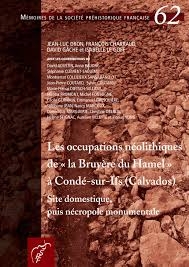
M62 - (2016) Les occupations néolithiques de "la Bruyère du Hamel" à Condé-sur-Ifs (Calvados) - Site Domestique, puis nécropole monumentale - J.-L. Dron, F. Charraud, D. Gâche et I. Le Goff
Résumé :
La Bruyère du Hamel est située en Normandie occidentale, dans la plaine de Caen. Le site est localisé sur le versant ouest de la rivière Laizon à 200 m de « Derrière les Prés » à Ernes. Il a été découvert fortuitement en 1988. Dix-neuf campagnes sur le terrain ont mis en évidence deux occupations du Néolithique moyen. Un sol avec structures fossoyées et mobilier abondant daté du premier quart du Ve millénaire avant notre ère a été fossilisé par un groupe de tombes à couloir de la seconde moitié du Ve millénaire.
La première phase correspond à une occupation « domestique ». Deux fours en sape, plusieurs fosses et un mobilier varié attestent d'activités diverses, malgré l'absence de bâti dans l'emprise archéologique. Les décors céramiques et l'industrie lithique de tradition VSG attribués aux débuts de la culture de Cerny posent la question du rôle de la région dans la genèse de la chalcolithisation.
Au cour de la nécropole monumentale d'Ernes-Condé, la phase funéraire recèle six tombeaux modestes, très proches les uns des autres. Seul le monument C livre un plan au sol et un niveau sépulcral complets. Sa durée d'utilisation est estimée par une série de dates 14C. La parenté biologique entre les douze défunts de ce caveau est approchée par une analyse génétique. Enfin, six fours à pierres chauffantes témoignent de repas de groupes liés à des gestes funéraires. Ainsi le modèle atlantique des sépultures collectives monumentales en pierre sèche intègre la Normandie, signant une nouvelle période de dynamisme occidental en direction de l'est.
Abstract :
La Bruyère du Hamel is situated in western Normandy, on the Caen plain. The site is located on the west side of the river Laizon, 200 m from 'Derrière les Prés' at Ernes. It was discovered by chance in 1988. Nineteen fieldwork campaigns uncovered two middle Neolithic occupations. A buried soil with pit features and numerous finds dating to the first quarter of the 5th millennium was preserved by a group of passage graves built in the second half of the 5th millennium.
The first phase corresponds to a 'domestic' occupation. Two underground ovens, several pits and varied finds provide evidence for a range of activities, despite the absence of buildings in the excavated area. The pottery decoration and the VSG tradition lithic industry, attributed to the beginnings of the Cerny culture, raise the question of the role of the region in the emergence of chalcolithisation.
In the heart of the Ernes-Condé monumental cemetery, the funerary phase includes six modest tombs, set very close to one another. Only monument C has a complete groundplan and burial layer. Its duration of use is estimated from a series of 14C dates. The question of the biological relationships of the twelve individuals in the tomb is addressed through a genetic analysis. Lastly, six hearths with heated stones indicate that communal meals were part of the funerary activity. Thus the Atlantic model of monumental dry-stone collective graves includes Normandy, marking a new period with developments in the west spreading in an easterly direction.
Société préhistorique française, 2016, 285 pages, ISBN : 2-913745-68-7 - EAN : 9782913745681 - 35 euros - réf : M62
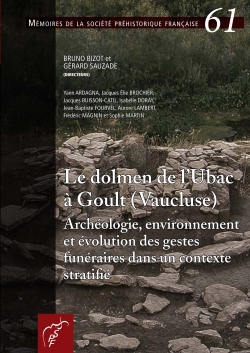
M61 - (2015) Le dolmen de l'Ubac à Goult (Vaucluse). - B. Bizot et G. Sauzade (dir.)
L'ouvrage est toujours disponible en version papier
Le dolmen de l'Ubac à Goult (Vaucluse). Archéologie, environnement et évolution des gestes funéraires dans un contexte stratifié sous la direction de Bruno Bizot et Gérard Sauzade, et de Yann ARDAGNA, Jacques Élie BROCHIER, Jacques BUISSON-CATIL, Isabelle DORAY, Jean-Baptiste FOURVEL, Aurore LAMBERT, Frédéric MAGNIN et Sophie MARTIN, , Paris, Société préhistorique française (Mémoires, 61), 2015 euro 248 pages - ISBN 2-913745-61-X.- 30 euro.
Le dolmen de l'Ubac a été découvert en 1994 à l'occasion d'une crue. Situé dans une plaine alluviale et au pied des premiers reliefs du Luberon, il a été protégé de toute altération par d'importants apports sédimentaires. La remarquable séquence stratigraphique en relation avec ce monument a offert l'opportunité de préciser l'évolution des apports sédimentaires et du couvert végétal depuis le Néolithique ancien jusqu'à l'âge du fer. La fouille intégrale du monument a pour sa part révélé une possible occupation funéraire de la fin du Néolithique moyen précédent la construction du dolmen entre 3300 et 2900 av. J-C. L'architecture de la chambre funéraire et du tertre ont pu être restitués. Tout au long de l'utilisation de la sépulture, ces structures emboîtées ont évolué sous le coup d'une altération progressive des éléments structurants et de remaniements anthropiques. Dans la chambre funéraire, des apports sédimentaires réguliers ont fossilisé les vestiges et quatre phases d'occupation ont pu être distinguées. Le fonctionnement de cette sépulture ayant accueilli une cinquantaine d'individus de tous âges et sexe et le traitement des cadavres ont pu être restitués pour chaque phase par l'étude in situ et l'analyse des vestiges osseux. Quelques caractères anthropologiques et paléopathologiques apportent des précisions sur les défunts. L'utilisation funéraire du site prend fin avant 2600 av J-C. Une fréquentation sporadique des lieux est encore perceptible à l'âge du Bronze ancien, avant que le monument soit totalement recouvert par les limons.
The Ubac long chamber dolmen was discovered in 1994 due to a flood. Located on an alluvial plain, at the foot of the slopes of the Luberon region, it had been protected from damage by thick sedimentary deposits. The remarkable stratigraphic sequence related to this monument has provided an opportunity to clarify the evolution of sedimentary deposits and plant cover from the early Neolithic to the Iron Age. Complete excavation of the monument has revealed a possible funerary occupation dating from the end of the Middle Neolithic, prior to construction of the dolmen between 3300 and 2900 BC. The architecture of the funerary chamber and the mound have been reconstituted. They evolved throughout the period of use of the tomb, due to both gradual deterioration of the structural elements and anthropogenic alterations. In the funerary chamber, regular sedimentary deposits -fossilised- the remains and four occupation phases have been identified. While in use, the tomb received some fifty individuals of all ages, both male and female, and it has proved possible to establish the treatment given to the corpses for each phase thanks to in situ research and analysis of the bone remains. Some anthropological and palaeopathological characteristics provide precise information on the deceased. Funerary use of the site ended before 2600 BC. Sporadic visits to the site were still evident during the Early Bronze Age, until the monument was completely covered by alluvia.
Recension dans le European Journal of Archaeology
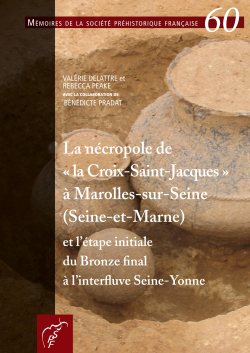
M60 - (2015) La nécropole de "la Croix-Saint-Jacques" à Marolles-sur-Seine" (Seine-et-Marne) et l'étape initiale du Bronze final à l'interfluve Seine-Yonne - V. Delattre et R. Peack
L'ouvrage est toujours disponible en version papier
La nécropole de "la Croix-Saint-Jacques" à Marolles-sur-Seine" (Seine-et-Marne) et l'étape initiale du Bronze final à l'interfluve Seine-Yonne Sous la drection de Valérie Delattre et Rebecca Peake avec la Collaboration de Bénédicte Pradat.
Mémoires de la société préhistorique française, 60
Paris, Société préhistorique française, 2015
ISBN : 2-913745-60-1 - 25 euro
La nécropole de « la Croix-Saint-Jacques » à Marolles-sur-Seine (Seine-et-Marne), fouillée en 2004 par l'INRAP, compte parmi les espaces funéraires de l'âge du Bronze les mieux conservés de la Bassée, comprenant 7 monuments funéraires pour 61 sépultures (10 inhumations et 51 incinérations). L'occupation, relativement courte, se concentre sur une période d'environ trois siècles (vers 1400 à 1100 av. J.-C.) qui la distingue nettement des nécropoles voisines de Marolles-sur-Seine « la Croix de la Mission » (40 sépultures sur 1500 ans) et « les Gours aux Lions » (une quarantaine de sépultures datées du Bronze final I au Bronze final IIIb). La quantité et la qualité des données issues de l'étude pluridisciplinaire de cet espace permettent une observation multiple et complémentaire des comportements humains et des gestuelles funéraires : incinéré ou inhumé, le défunt et son mobilier d'accompagnement (panoplie personnelle, armement, parure, accessoires vestimentaires, offrandes alimentaires) participent de la mise en scène individuelle et collective de la mort, de façon aussi bien souterraine (coffrage imposant, agencement codifié des dépôts) qu'aérienne (érection de monuments tumulaires qui s'inscrivent de façon pérenne dans le paysage). La grille de lecture ainsi définie permet d'appréhender la gestion de la mort et des morts à la fin de l'âge du Bronze dans la vallée de la haute Seine.
The 'La Croix-Saint-Jacques' cemetery at Marolles-sur-Seine (Seine-et-Marne) is one of the best preserved Bronze Age funerary sites in 'La Bassée'. Excavations by INRAP in 2004 have revealed 7 monuments and 61 tombs of which 10 are inhumations and 51 cremations. The cemetery was used for only about three centuries (1400-1100 BCE) setting it apart from neighbouring sites in Marolles-sur-Seine. 'La Croix-de-la-Mission' contains 40 tombs from a period of over 1500 years while over 40 tombs at 'Les Gours-aux-Lions' cover most of the Late Bronze Age.
The quality and quantity of data from this interdisciplinary study has provided evidence of funerary behaviour and tradition. Whether cremated or buried, the dead and the objects which accompany them (personal effects, weapons, adornments, offerings of food) participate in the individual and collective staging of death, from the codified organisation of objects in the tomb and the large funerary chambers to the building of monuments that permanently mark the surrounding countryside. This framework gives an insight into how death was perceived and managed during the Late Bronze Age in the upper Seine Valley.
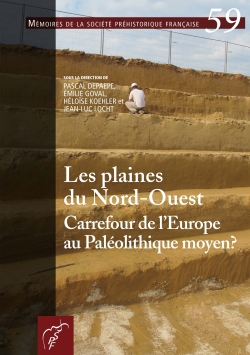
M59 - (2015) Les plaines du Nord-Ouest : carrefour de l'Europe au Paléolithique moyen ? - P. Depaepe, E. Goval, H. Koehler et J.-L. Lotch
L'ouvrage est toujours disponible en version papier
Les plaines du Nord-Ouest : carrefour de l'Europe au Paléolithique moyen ?
Sous la direction de Pascal Depaepe, Émilie Goval, Héloïse Koehler et Jean-Luc Locht
Mémoires de la société préhistorique française, 59
Paris, Société préhistorique française, 2015
ISBN : 2-913745-58-X - 35 euro
Grâce aux découvertes et aux analyses menées ces vingt dernières années sur les sites de l'Europe du Nord-Ouest, il est désormais possible d'aborder le fonctionnement de cet espace géographique et son rôle dans la diffusion des cultures du Paléolithique moyen. En mars 2008, les journées thématiques de la Société préhistorique française se sont tenues à Amiens. La question posée aux participants de cette rencontre scientifique était la suivante : les plaines du Nord-Ouest étaient-elles le carrefour de l'Europe au Paléolithique moyen... Par cette manifestation, il s'agissait de dresser le bilan des connaissances sur les différents systèmes techniques qui apparaissent dans cet espace géographique, d'engager une approche des territoires paléolithiques et des contacts entre le Nord, l'Ouest et le Sud de l'Europe. Il s'agissait non seulement de présenter de nouvelles données archéologiques mais également d'aborder de manière synthétique différents faciès du Paléolithique moyen selon des aires chronoculturelles spécifiques.
Seize communications ont été rassemblées au sein de cet ouvrage abordant des thématiques diverses mais complémentaires. Ainsi est présenté le cadre général dans lesquelles s'inscrivent les plaines du Nord-Ouest au Paléolithique moyen, puis trois grandes sphères géographiques sont abordées : les données du Nord de la France et du Bassin parisien, celles de l'Ouest et du Sud-Ouest de la France et enfin leur confrontation à l'Europe du Nord-Ouest (Grande-Bretagne,
Belgique et Allemagne essentiellement). Le lecteur aura également plaisir à nourrir sa réflexion à la fin de cet ouvrage où l'ensemble des discussions ayant eu lieu durant ces journées ont été retranscrites.
As a result of discoveries and analyses carried out over the last twenty years at Northwest European sites, it is now possible to address the use of this geographic region and its role in the spread of Middle Paleolithic cultures. In March 2008, the themed days organized by the Société préhistorique française were held in Amiens. The question asked of the participants at this scientific meeting was the following: Did the northwest plains serve as the crossroads of Europe during the Middle Paleolithic? The aim of the meeting was to present summaries of current knowledge regarding different technical systems that appear in this geographic area and develop an approach to study Paleolithic territories and contacts between Northern, Western and Southern Europe. This included not only the presentation of new archaeological data, but also broader discussion of the different Middle Paleolithic facies by specific chronocultural areas.
Sixteen communications are offered in this work, focusing on different but complementary topics. The wider context in which the northwest plains are found during the Middle Paleolithic is thus presented, in which three broad geographic regions are examined: data from Northern France and the Paris Basin, Western and the South of France and finally, their comparison with Northwest Europe (essentially Great Britain, Belgium and Germany). The reader will also benefit from the transcripts of all discussions that took place during the meeting, found at the end of this volume.
Recension dans le European Journal of Archaeology
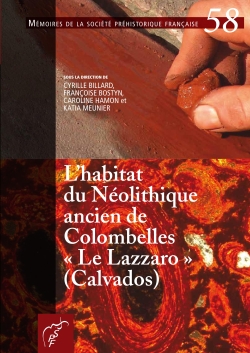
M58 - (2015) L'habitat du Néolithique ancien de Colombelles « Le Lazzaro » (Calvados) - C. Billard, F. Bostyn, C. Hamon et K. Meunier
L'ouvrage est toujours disponible en version papier
Depuis les années 1970, la composante orientale, en particulier celle de la céramique Linéaire, dans l'origine du premier Néolithique normand n'a cessé d'être confortée. L'intrigante découverte de la fameuse céramique de la Hoguette à Fontenay-le-Marmion (Calvados) constituait un premier signal. Plus récemment, les découvertes successives ont confirmé l'existence de nombreux sites d'habitat de la culture de Blicquy/Villeneuve-Saint-Germain.
La fouille du site de Colombelles montre aujourd'hui que l'Ouest du Bassin parisien s'inscrit bien dans la sphère de la colonisation rubanée à la fin du VIe millénaire av. J.-C. Avec une dizaine d'unités d'habitation alignées sur une même rangée orientée nord-sud, ce village offre tous les signes d'une transmission rigoureuse des normes culturelles rubanées, tant dans ses dimensions matérielles qu'économiques ou sociales. Seul l'attrait pour de nouvelles ressources minérales, telles que l'hématite oolithique ordovicienne, les silex jurassiques ou les schistes, distingue Colombelles des sites plus continentaux.
La situation isolée de ce site vers l'ouest n'est pas sans soulever des questions quant au rythme de l'expansion rubanée à partir des zones colonisées antérieurement, cette progression étant difficilement compatible avec une colonisation agricole lente. La fin de la céramique Linéaire semble donc s'accompagner d'une avancée rapide des groupes villageois...; elle apparaît également comme une phase d'ouverture vers la sphère méridionale, comme en témoigne, à Colombelles, la présence de parures fabriquées dans des matériaux provenant des régions méditerranéennes.
L'analyse spatiale tente ici de pallier le manque de données sur l'architecture de la maison rubanée. Avec ses structures délicates à percevoir en milieu limoneux, la fouille pose également, plus globalement, la question de la détection de ce type d'habitat, en particulier dans les zones de plateau.
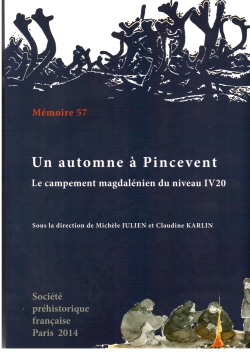
M57 - (2014) Un automne à Pincevent : Le campement magdalénien du niveau IV20 - M. Julien et C. Karlin Collectif
TELECHARGER LE DOCUMENT (1ère partie)
TELECHARGER LE DOCUMENT (2èmepartie)
L'ouvrage Un automne à Pincevent. Le campement du niveau IV20 présente trente années de fouilles conduites d'abord sous l'autorité de A. Leroi-Gourhan et M. Brézillon, puis sous une direction collective. Pour la première fois en France, un campement paléolithique s'étendant sur près de 5000 m2 permet de reconstituer la vie de chasseurs de rennes d'il y a treize mille ans. L'étude, résolument palethnologique, se fonde à la fois sur une description des faits archéologiques et sur une interprétation enrichie par des données ethnoarchéologiques. Le contexte naturel du site est d'abord présenté, puis le campement lui-même, établi à proximité d'un lieu de passage des rennes à l'automne. Un inventaire de l'équipement est complété par une analyse des techniques du travail du silex et du bois de renne. L'étude de l'organisation et de la fonction de la vingtaine d'unités d'occupation concerne d'abord les quatre résidences centrales, puis les ateliers techniques périphériques, et l'on s'interroge sur la nature des rapports sociaux entre les familles de chasseurs. Celles-ci paraissent avoir obéi à un individu particulier dont l'expérience permettait d'orienter les stratégies de la chasse. Plusieurs aspects du mode de vie de ces Magdaléniens : chasse collective, partage du gibier, fabrication de l'équipement sont enfin évoqués.
The publication One autumn in Pincevent. The level IV20 camp is presenting thirty years of excavations conducted at first under the authority of A. Leroi-Gourhan and M. Brézillon, then under a collective leadership. For the first time in France, the palaethnological study of a palaeolithic camp, extending over an area of nearly 5,000 square meters, allows the reconstitution of the life of reindeer hunters 13,000 years ago. This study is based on both a description of the archaeological facts and an interpretation enhanced by the contribution of ethnoarchaeological data. After the presentation of the site in its natural context and the presentation of this residential camp set up by a reindeer autumnal migration route, an inventory of the equipment is drawn up, also showing the flint and reindeer antler working techniques. The analysis of the organisation and function of the 20 occupation-units is first dedicated to the four central habitation units, then to the peripheral technical units, questioning the nature of the relationships between the families of hunters. It seems that the group was submitted to the authority of one person whose great experience allowed the orientation of the hunting strategies. Several aspects of the way of life of these Magdalenians are finally evoked: collective hunting practices, sharing of the game, manufacturing of the equipment.
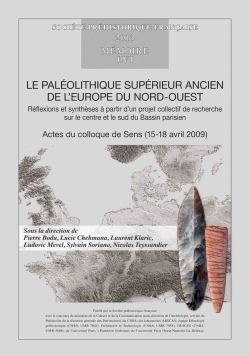
M56 pdf - (2013) Le Paléolithique supérieur ancien de l'Europe du Nord-Ouest - P. Bodu, L. Chehmana, L. Klaric, L. Mevel, S. Soriano, N. Teyssandier
Actes du colloque de Sens (15-18 avril 2009) : Réflexions et synthèses à partir d'un projet collectif de recherche sur le centre et le sud du Bassin parisien - Sous la direction de Pierre Bodu, Lucie Chehmana, Laurent Klaric, Ludovic Mevel, Sylvain Soriano et Nicolas Teyssandier
Cet ouvrage présente les actes du colloque « Le Paléolithique supérieur ancien (35000-15000 BP) de l'Europe du Nord-Ouest » qui s'est tenu au musée de Sens (Yonne) en avril 2009. Il regroupe vingt-sept contributions qui permettent de dresser un état des recherches sur les groupes humains depuis la transition entre le Paléolithique moyen et le Paléolithique supérieur jusqu'à l'avènement des sociétés magdaléniennes, et ce depuis le seuil du Poitou jusqu'aux rives de l'Oder. L'ouvrage est d'abord dédié à un solide bilan des données acquises ces dix dernières années sur les différents ensembles chronologiques du Bassin parisien, depuis l'Aurignacien jusqu'au Magdalénien moyen. Si les industries lithiques représentent le socle de nos réflexions, des analyses qui étaient, jusqu'alors, marginales dans le Bassin parisien (technologie osseuse, taphonomie) ont également été menées. Les comparaisons avec les recherches conduites dans les régions voisines (Bretagne, Centre, Est, Nord et Normandie) mais aussi avec celles menées dans d'autres pays de l'Europe nord-occidentale (Allemagne, Belgique, Luxembourg, Royaume-Uni et Suisse) apportent à cette approche régionale ciblée le recul nécessaire à la compréhension de phénomènes humains transfrontaliers. Ces contributions abordent des thématiques inédites sur le Paléolithique supérieur ancien ou exposent des bilans régionaux et chronologiques synthétiques. Dans les deux cas, les auteurs se sont attachés à replacer leur présentation dans le contexte chronologique général du Paléolithique supérieur de la région et/ou du pays concernés.
This book presents the Acts of the conference «Le Paléolithique supérieur ancien (35000-15000 BP) de l'Europe du Nord-Ouest», held at the Museum of Sens (Yonne) in April 2009. It includes twenty-seven contributions that reflect the state of research on human groups from the Middle to Upper Palaeolithic transition to the appearance of Magdalenian societies, from the threshold of Poitou to the banks of the Oder. This work is first dedicated to a solid overview of data acquired in the preceding decade for the different chronological groups in the Paris Basin, from the Aurignacian to the Middle Magdalenian. While lithic industries represent the foundation for our interpretations, analyses that were previously marginal in the Paris Basin (bone technology, taphonomy) were also carried out. Comparisons with research conducted in neighbouring regions (Brittany, Central, Eastern and Northern France and Normandy) and with other countries in Northwest Europe (Germany, Belgium, Luxembourg, Great Britain and Switzerland) offer this regional and targeted approach the perspective necessary to explain cross-border human phenomena. These contributions address new topics regarding the Early Upper Palaeolithic or present regional overviews and synthetic chronologies. For both, the authors place their work in the general chronological context of the Upper Palaeolithic of the region and/or the countries involved.
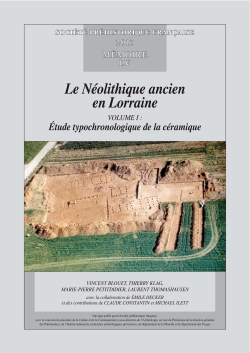
M55 - (2013) Le Néolithique ancien en Lorraine - V. Blouet, Th. Klag, M.-P. Petitdidier, L. Thomashausen
L'ouvrage est toujours disponible en version papier
Téléchargez le document (volume 1)
Téléchargez le document (volume 2)
avec la collaboration de É. Decker, G. Belland, Ch Bouvret, A. Gambs et J. -L. Kieffer et des contributions de C. Constantin et M. Ilett
Située dans le quart nord-est de la France, la Lorraine constitue, de par sa situation géo-graphique, une région privilégiée pour l'étude des interactions entre le bassin du Rhin et le Bassin parisien au Néolithique ancien. Avec le développement de l'archéologie préventive, la connaissance sur cette période a spectaculairement progressé. Ces trente dernières années, trente-huit sites ont fait l'objet de fouilles ponctuelles ou de plus grande ampleur mais les résultats en sont pour la plupart inédits. Les deux premiers volumes du « Néolithique ancien de Lorraine » visent à combler cette lacune. Le premier présente l'étude de la céramique décorée réalisée sur un corpus de plus de 12 000 vases. Une périodisation régionale en neuf phases, pour deux d'entre elles subdivisées en sous-stades, a pu être établie à partir d'analyses statistiques. Le début de l'occupation date d'une phase évoluée du style de Flomborn et la séquence s'achève à un stade terminal du Rubané contemporain de la fin de Hinkelstein et du début du Villeneuve-Saint-Germain. Des comparaisons réalisées avec les régions voisines précisent la définition des différents styles régionaux qui caractérisent l'Ouest du monde rubané et permettent d'examiner les interactions entretenues entre ces groupes. Le second volume présente de manière détaillée tous les sites attribués à la culture rubanée recensés en Lorraine. A ce jour, on y recense soixante-deux sites d'habitat, implantés dans deux secteurs distincts. Le premier, situé en Lorraine du Nord en aval de Metz, constitue le prolongement des aires de peuplement rubané de la Moselle allemande et luxembourgeoise. Le second, implanté dans la plaine sous-vosgienne en Lorraine du Sud, se trouve à mi-chemin entre les zones d'implantation rubanées d'Alsace et de Champagne. Le troisième volume, à paraître, abordera les questions ayant trait à l'économie par l'étude des industries lithiques et osseuses et des analyses archéozoologiques et botaniques. Il traitera également des problématiques relatives à la dynamique de peuplement et à l'occupation du territoire.

M54 - (2012) D'une révolution à l'autre. Pour une épistémologie de la problématique de transition en Préhistoire Virginie Guillomet-Malmassari
L'ouvrage est toujours disponible en version papier
Cet ouvrage propose une analyse épistémologique des études qui abordent le phénomène de transition en préhistoire (au sens de « passage d'un état à un autre »). Deux cas de transition sont considérés : le passage du Paléolithique moyen au Paléolithique supérieur ; le passage du Paléolithique au Néolithique. Ces transitions suscitent des interprétations opposées, d'ordre historico-culturel (évolution in situ versus migration), étudiées ici sous l'angle de l'opposition « continuité-discontinuité en Europe ». Elles sont examinées depuis leur première formulation, au xixe siècle, jusqu'à aujourd'hui. A l'issue de cette analyse historiographique approfondie et ciblée, plusieurs aspects sont dégagés. Le développement de la controverse se caractérise notamment par un processus d'interaction scientifique fructueux, en termes de construction chrono-culturelle. Toutefois la persistance de cette interprétation dichotomique de la transition sur le long terme conduit à discuter de la validité des modèles interprétatifs en vigueur, par rapport à la complexité des données archéologiques, telle qu'on l'observe aujourd'hui. Il apparaît enfin que la controverse sur l'interprétation historico-culturelle de la transition masque une problématique fondamentale mais non définie comme telle : celle des mécanismes du changement culturel.
This book propose an epistemologic analysis of the studies which approach the phenomenon of transition in prehistory (in the sense of a passage from a state to the other one). Two cases of transition are considered : the one between the middle and upper Palaeolithic ; the other between the Palaeolithic and the Neolithic. These transitions arouse interpretations of "historico-cultural" order set (evolution in situ versus migration), studied here under the angle of the opposition "continuity-discontinuity in Europe" These are examined since their first formulation, in 19th century, until today. At the conclusion of this detailed and targeted historiographical analysis, several aspects are outlined. The development of the controversy is characterized by a fruitful scientific process of interaction in terms of chrono-cultural construction. Nevertheless, the obstinacy of the dichotomous interpretation of the transition, on the long term, leads to discuss the validity of the interpretative models proposed with regard to the complexity of the archaeological data, such as we observe it today. Lastly, it seems that the controversy on the historico-cultural interpretation of the transition masks a fundamental but not recognized problem, nor shown as such : that of the mechanisms of the cultural change
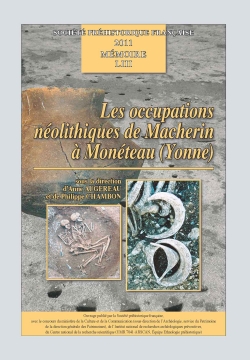
M53 - (2011) Les occupations néolithiques de Macherin à Monéteau (Yonne) - A. Augereau et P. Chambon (dir.)
L'ouvrage est toujours disponible en version papier
Les occupations néolithiques de Macherin à Monéteau (Yonne) - A. Augereau et P. Chambon (dir.), 422 pages - Le site de Macherin à Monéteau (Yonne), à la confluence de l'Yonne avec le Ru de Baulche, a révélé des occupations du Néolithique ancien à la période antique. Pour le Néolithique, les 11 habitations témoignent d'une occupation de la fin du Rubané à l'extrême fin du Villeneuve-Saint-Germain. Une sépulture associée présente pourtant des caractéristiques peu danubiennes : crânes de suinés en dépôt, tête au sud-est. L'apport le plus remarquable est constitué par la nécropole du Néolithique moyen : 3 ensembles différemment structurés regroupent 52 sépultures, 61 inhumés, 82 objets associés, ainsi que des dispositifs connexes. Il s'agit d'un corpus essentiel : coffres, contenants mobiles, fosses à couvercle, dépôts de vases après fermeture de la tombe, variabilité des registres des mobiliers funéraires, etc. Sur le plan culturel, les pratiques renvoient à diverses sphères : nord-orientale, méridionale, occidentale, Cerny, Chasséen... Contemporaine ou à peine postérieure, une enceinte palissadée enclot un vaste espace de 10 hectares. Les entrées sont peu nombreuses et étroites, les traces d'une installation domestique sont peu caractéristiques : de rares fosses, peu de mobilier et aucun bâtiment. La fin du Néolithique est représentée par des témoins originaux et inédits : sépulture en coffre de pierres contenant plusieurs individus et d'énigmatiques structures funéraires (« STZ »). Le gisement de Macherin, dont il subsiste des parcelles inexplorées, s'impose comme un gisement majeur : vaste village danubien, nécropole hors norme du Néolithique moyen et vaste enceinte, structures funéraires inédites de la fin du Néolithique.
The site of Macherin, at the confluence of the Yonne and Baulche Rivers, contains settlements from the Neolithic to the Gallo-Roman... In the Neolithic, eleven buildings indicate an occupation from the end of the Rubané to the final phase of the Villeneuve-St-Germain culture. A burial also dates to this period, but lacks Danubian characteristics: deposition of suinae skulls, with the head to the south-west and a flint blade. The most remarkable aspect of the site are the Middle Neolithic mortuaries: three groups of different organization comprising 52 burials, 61 individuals associated with 82 objects and several additional features. This is an essential corpus: chests, portable containers, covered pit graves, deposition of ceramics after the closure of the tomb, variation in burial goods. In terms of cultural affiliation, the burial practices refer to a variety of cultural spheres to the northeast, west, east, Cerny, Chassean...Contemporary with the burials, or slightly later in date, a palisaded ditch enclosed a large area, approximately 10 hectares. Entrances are rare and narrow, and the traces of domestic occupation are scarce and uncharacteristic: a few scattered pits, very few artefacts and no buildings. The Late and Final Neolithic is represented by unique and unusual finds: a stone burial vault containing several individuals and some enigmatic funerary structures (Z-type features). Macherin, which is not completely excavated, retaining unexplored areas, has become a major site: a large Danubian village, an exceptional cemetery and a large enclosure of the Middle Neolithic, and unusual funerary features from the Late Neolihic.
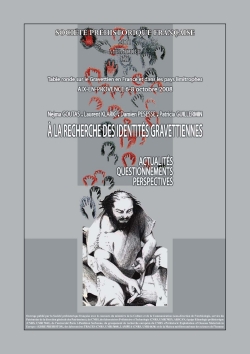
M52PDF - (2011) A la recherche des identités gravettiennes : actualités, questionnements et perspectives. Actes de la table ronde d'Aix-en-Provence, 6-8 octobre 2008 - N. GOUTAS, L. KLARIC, D. PESESSE, P. GUILLERMIN, dir
Télécharger le document (1ère partie)
Télécharger le document (2ème partie)
Télécharger le document (3ème partie)
Cet ouvrage thématique, édité à la suite de la table ronde qui s'est tenue à Aix-en-Provence en 2008, regroupe les résultats de travaux inédits ou récents sur le Gravettien en France et dans les pays limitrophes (sud de l'Allemagne, piémont pyrénéen espagnol et Italie). L'objectif de cette manifestation était de mettre en valeur les nouveaux axes forts de la recherche sur cette période majeure du Paléolithique supérieur. Au cours de ces trois journées, qui ont réuni différents acteurs de la recherche (chercheurs confirmés, jeunes chercheurs et étudiants), l'accent a été mis sur les études récentes et sur les nouvelles fouilles archéologiques qui ont apporté des éléments de discussion permettant de relancer le débat sur l'identité des groupes gravettiens et, plus largement, sur la définition du Gravettien en tant que technocomplexe homogène et paneuropéen.
Un des objectifs de cette rencontre était d'accorder une large place aux travaux universitaires réalisés dans le cadre de masters et surtout de doctorats ou de postdoctorats, souvent très innovants et qui contribuent, en première ligne, à la recherche des laboratoires. A partir de cet état des lieux, il a été possible de mettre en lumière aussi bien les progrès récents que les lacunes qui restent à combler. La première partie du volume est consacrée aux économies gravettiennes. Les questions relatives à la gestion, l'acquisition et l'exploitation des ressources minérales et animales dans une perspective de fabrication et de consommation y sont traitées.
La deuxième partie de l'ouvrage aborde plus particulièrement les problématiques liées à la chronologie et à la sériation du Gravettien. Dans la mesure du possible, les nouveaux résultats ont été confrontés aux anciens modèles hérités d'une historiographie longue et complexe. La troisième partie traite des « identités gravettiennes » au sens large, à la fois à travers des nouvelles données de l'anthropologie physique, des pratiques funéraires, artistiques et des caractères identitaires des productions techniques. Enfin, cet ouvrage s'achève sur les actualités de terrain, la quatrième et dernière partie traitant des nouvelles données de fouilles, terreau incontournable du renouvellement de nos connaissances sur le Gravettien.
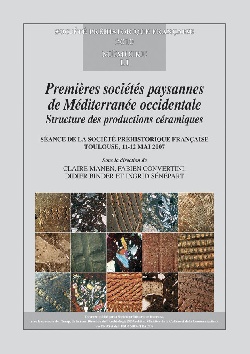
M51PDF - (2010) Premières sociétés paysannes de Méditerranée occidentale Structures des productions céramiques - sous la direction de Claire MANEN, Fabien CONVERTINI, Didier BINDER et Ingrid SÉNÉPART
Premières sociétés paysannes de Méditerranée occidentale - Structures des productions céramiques sous la direction de Claire MANEN, Fabien CONVERTINI, Didier BINDER et Ingrid SÉNÉPART (Séance de la Société préhistorique française, Toulouse, 11-12 mai 2007)
Cet ouvrage regroupe les résultats de travaux menés sur les productions céramiques du Néolithique ancien méditerranéen. Une partie de ces études a été réalisée dans le cadre d'une Action collective de recherche (ACR) organisée autour des structures de production céramique des premières sociétés paysannes du Sud de la France et de la Catalogne. Mais nous avons également voulu confronter cette recherche à des démarches similaires réalisées sur le pourtour de la Méditerranée occidentale et faire ainsi le point sur les recherches dévolues au Néolithique ancien de cette vaste aire géographique. La première partie du volume est consacrée aux approches méthodologiques développées, non seulement dans le cadre de cette ACR mais également par d'autres chercheurs, pour l'analyse des productions céramiques du Néolithique ancien. La deuxième partie rassemble plusieurs articles relatifs à l'organisation des productions céramiques du Nélithique ancien de l'Italie, du Sud de la France et de l'Espagne. Les principaux résultats issus du programme ACR sont ici présentés. La troisième partie de l'ouvrage réunit huit contributions constituant un état des lieux des recherches sur le Néolithique ancien de Méditerranée occidentale. Les aspects géographiques et chronoculturels sont plus particulièrement abordés. Enfin, la quatrième partie offre des regards croisés sur la dynamique des productions céramiques. Prenant appui sur des bases méthodologiques renouvelées, cette publication propose ainsi un bilan de la recherche consacrée au Néolithique ancien de Méditerranée occidentale.
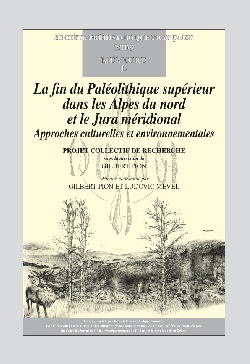
M50PDF - (2009) La fin du Paléolithique supérieur dans les Alpes du nord françaises et le Jura méridional. Approches culturelles et environnementales - G. PION et L. MEVEL(dir.)
L'ouvrage est toujours disponible en version papier
Ce programme de recherche collectif centré sur la fin du Paléolithique supérieur dans les Alpes du nord et le Jura méridional a démarré en 1997 sous l'impulsion de Jean-Pierre Daugas, à l'époque conservateur régional de l'Archéologie de la région Rhône Alpes. Après une première phase de recueil des données disponibles et de leur restitution, il nous a paru utile de concevoir un programme de recherche étalé sur sept années. Ce programme défini avec les préhistoriens, les spécialistes du paléoenvironnement végétal et animal et ceux de la chronologie par les datations radiocarbone, a été l'occasion de valoriser les recherches anciennes et plus récentes, en particulier en replaçant les données disponibles dans un contexte le plus large possible. Les travaux engagés par l'équipe du PCR se sont concentrés sur deux grands thèmes. Le premier centré sur la définition du cadre environnemental du Tardiglaciaire régional depuis le Dryas ancien jusqu'au début de l'Allerød (15000-11800 BP) en s'appuyant à la fois sur toutes les datations radiocarbone et sur celles de la palynologie, de l'anthracologie et de la microfaune. Les analyses des spectres fauniques des gisements tardiglaciaires de la région ont permis de préciser la dynamique de la recomposition des milieux par le monde animal en particulier pour le Renne, en s'appuyant sur les analyses archéozoologiques avec l'apport des analyses isotopiques. Les résultats présentés dans cet ouvrage contribuent finalement à renouveler et enrichir nos connaissances sur les environnements occupés par les derniers chasseurs-cueilleurs du Paléolithique supérieur. Le deuxième thème concerne plus particulièrement les questions liées à la variabilité des comportements techniques et économiques au cours de ce Tardiglaciaire qui ont vu succéder aux derniers chasseurs magdaléniens les premiers groupes aziliens. La caractérisation des matières premières siliceuses et leur circulation se sont imposées comme des thématiques majeures au regard de la richesse des ressources disponibles et de leur variabilité constatée dans les séries archéologiques étudiées. En proposant de premières réflexions sur ces problématiques techno-économiques et culturelles, les travaux présentés dans ce volume apportent de nouveaux éléments de compréhension aux phénomènes de mutation des industries lithiques régionales. Cet ouvrage n'a pas la prétention de proposer une synthèse complète des recherches effectuées depuis des décennies dans l'espace géographique du PCR mais plutôt de présenter les premiers résultats interdisciplinaires inédits et définir ainsi de nouvelles perspectives de recherche pour les années à venir.
This Collective Research Program (CRP), centred on the final Upper
Palaeolithic in the northern part of the Alps and the southernmost part of
the Jura Mountains, started in 1997 urged on by Jean-Pierre DAUGAS,
then regional Curator of the archaeology of the Rhone-Alps area. After a
first phase of collecting the available data and their restitution, it appeared
useful to us to conceive a research program spread out over seven years.
This program, conceived with the prehistorians, with the specialists in
vegetal and animal Paleoenvironnement and with those of the chronology
by radiocarbon dating, was the occasion to highlight old and recent
research and buckle down to put back the available data within the broadest possible context. The work carried out by the team concentrated on two topics. The first has mainly focused on the definition of the environmental setting from the Older Dryas to the beginning of the Allerød (15000-11800 BP) based as much on the data obtained from radiocarbon dating than on the data obtained from palynology and anthracology. The analyses of the faunal spectra from the Late Glacial layers in the region made it possible to understand the progressive transformation of the fauna due to climatic change, based on zooarchaeological analysis and with the contribution of isotopic analyses. The results presented in this work finally contribute to the renewal and enrichment of our knowledge on the environments occupied by the last hunters-gatherers of the Upper Palaeolithic. The second topic has mainly focused on questions relating to the variability of technical and economic behaviours during these periods, which saw the succession of the last Magdalenian hunters and the first Azilian groups. The characterization of the siliceous raw materials and the analysis of their circulation became major topics given the richness of the available resources and their variability within the studied archaeological assemblages. By proposing a first set of remarks on these techno-economic and cultural problems, the various work presented in this volume contribute, by bringing new elements, to the understanding of the mutation phenomena of regional lithic industries. This work does not claim to propose a complete synthesis of the research carried out for decades in the CRP's geographical area, but rather to present unpublished interdisciplinary preliminary results and to thus define new research tracks for the years to come.
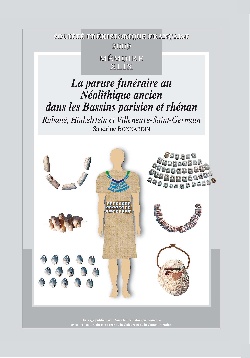
M49 - (2009) La parure funéraire des premières sociétés agro-pastorales des Bassins parisien et rhénan : Rubané, Hinkesltein et Villeneuve-Saint-Germain - S. BONNARDIN
L'ouvrage est toujours disponible en version papier
Téléchargez le document (vol.1)
Téléchargez le document (vol.2)
La parure funéraire au Néolithique ancien dans les Bassins parisien et rhénan. Rubané, Hinkelstein et Villeneuve-Saint-Germain Ouvrage publié par la Société préhistorique française avec le concours du ministère de la Culture et de la Communication Pendant près de sept siècles, alors que le Néolithique ancien progresse à travers le Bassin rhénan et rejoint le Bassin parisien, les premières sociétés agro-pastorales qui le caractérisent (Rubané, Hinkelstein, Villeneuve-Saint-Germain) vont déposer dans les tombes des défunts des dizaines et des dizaines d'objets de parure, façonnés selon des méthodes plus ou moins complexes et dans des matériaux aux provenances parfois très lointaines (spondyle). Ces objets composent des parures variées qui sont le reflet des goûts et des valeurs des groupes qui les portent. Comment ont été manipulés ces objets au cours du temps ? Ont-ils été utilisés avant d'être déposés dans les tombes ou bien peut-on concevoir que certains ont été réalisés spécifiquement pour le défunt ? Comment les a-t-on porté, disposé sur le corps ? Quelles décorations corporelles ont-ils formé ? Quelle est leur conception technique ? Mais aussi, à qui a-t-on destiné ces productions ? Toute catégorie d'âge y a-t-elle eu accès à cette période ou a-t-on fabriqué des parures spécifiquement pour les femmes, les hommes et les enfants ? Plus largement, enfin, comment a évolué ce matériel au cours du Néolithique ancien ? Quelle place lui a-t-on réservée ? A travers une étude des matières premières, une analyse typologique, technologique et tracéologique de la quasi totalité des corpus du Bassin parisien et du Bassin rhénan, cet ouvrage se propose d'examiner pour la première fois les aspects technique, fonctionnel et social de ce matériel si particulier. La corrélation de l'ensemble des résultats avec les données de terrain (position des objets sur le squelette, associations d'objets, etc.) permettent de reconstituer la vêture funéraire des premiers paysans de l'extrême Ouest de l'Europe tempérée. Les résultats mettent aussi en relief la distension des liens qui unissent les communautés du Bassin parisien et du Bassin rhénan lorsque le Rubané se délite pour laisser la place aux nouveaux groupes culturels qui émergent, le Hinkelstein et le Villeneuve-Saint-Germain. En ce début du Ve millénaire avant J.-C., les relations culturelles ont changé, la parure s'en fait l'écho.
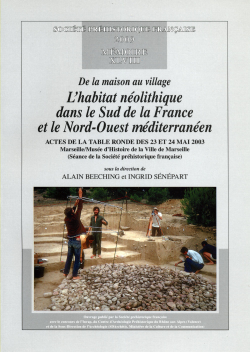
M48PDF - (2009) De la maison au village. L'habitat néolithique dans le Sud de la France et le Nord-Ouest méditerranéen ACTES DE LA TABLE RONDE des 23 et 24 mai 2003 Marseille/Musée d'Histoire de la Ville de Marseille (Séance de la SPF)
Sous la direction d'Alain BEECHING et Ingrid SENEPART
Cet ouvrage tente de répondre à une série de questions implicites qui s'enracinent dans un problème de fond mal élucidé : bien que le premier impact néolithique sur le sol français soit méridional, lointain et tardif écho des bouleversements proche-orientaux dans les façons de vivre et de penser la société, nous ignorons en grande partie comment il s'est ancré dans le paysage ? En d'autres termes : à quoi ressemblent les maisons des premiers agro-pasteurs plus ou moins sédentarisés ? Quelles formes prennent les premiers villages de notre histoire ou, à défaut, les premiers lieux de vie groupée un peu durable ? Peut-on déceler là les germes des comportements protohistoriques et historiques en matière d'ancrage au sol nourricier ? Après une longue période de carence durant laquelle, malgré quelques belles exceptions rappelées en historique, les archéologues méridionaux avaient tardé à « sortir des grottes » pour aller étudier les lieux de vie ouverts ; après un véritable vide des connaissances en matière d'habitat à l'exception des stades les plus tardifs qui avaient déjà attiré l'attention avec les spectaculaires constructions en pierres sèches, ce recueil comble à lui seul une part du retard accumulé. Il publie les quatre seuls cas clairement attestés de structures habitées du Néolithique ancien méridional, fixant du même coup l'esquisse d'un modèle de maison. Il donne au Chasséen de ces régions les premiers cas complets et indiscutables de bâtiments, et par là accentue l'interrogation sur les causes de cette rareté. Il complète une vision déjà riche du Néolithique final en documentant des situations et des matériaux nouveaux à côté de la « pierre-reine » ; par exemple en révélant enfin la place de la construction en terre et en poursuivant la réflexion sur les habitats ceinturés. Le midi n'est donc plus en retard. Il peut confronter ses résultats avec ceux des régions et pays voisins afin de jeter les bases d'une réflexion à l'échelle de tout le Nord-Ouest méditerranéen.
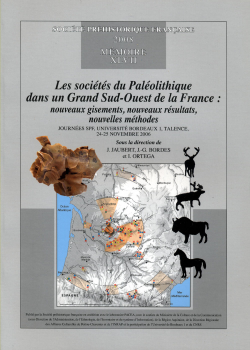
M47PDF - (2008) Les sociétés du Paléolithique dans un Grand Sud-Ouest de la France : nouveaux gisements, nouveaux résultats, nouvelles méthodes JOURNÉES SPF, UNIVERSITÉ BORDEAUX 1, TALENCE, 24-25 novembre 2006
Sous la direction de Jacques JAUBERT, Jean-Guillaume BORDES et illuminada ORTEGA
Ces dernières années se sont généralisées dans le Sud-Ouest de la France importantes fouilles archéologiques préventives qui ont principalement mais pas seulement concerné le Paléolithique. Les liaisons autoroutières Bordeaux, Clermont-Ferrand via Périgueux et Brive (A89), la déviation de Bergerac (Dordogne), dans une moindre mesure l'A20 (Brive-Montauban) et les travaux liés aux différents aménagements de construction de l'A380 dans la région toulousaine. Ainsi, dans un délai assez court, une documentation a renouvelé,ou a tout le moins complété, presque tous les stades du Paléolithique avec des points forts pour la phase la plus ancienne du Paléolithique moyen et la question des survivances acheuléennes (OIS 8-6), le Châtelperronien, l'Aurignacien, le Solutréen et les prémices du Magdalénien. Ajoutée à quelques nouvelles séquences (Jonzac, Taillis des Coteaux) cette documentation actualise de manière exceptionnelle les bilans paléolithiques du Sud-Ouest, en complétant les données apportées par les fameux sites sous abris de référence. En effet, les bilans chronologiques ou archéostratigraphiques demeurent, par leur exceptionnelle dilatation ou découvertes spectaculaires (sépultures néandertaliennes, restes humains), sans réelle concurrence pour certains questionnements comme la subsistance alimentaire déduite de l'étude des archéofaunes, la succession des techno-complexes, le statut économique et saisonnier de ces occupations ou la présence de témoignages d'ordre esthétique (parure) ou spirituel (colorants), voire graphiques (art mobilier, pariétal), généralement inexistants, ou presque, sur les sites de plein air. Cet ouvrage n'a pas la prétention de proposer une synthèse dans tous les secteurs de cette riche et foisonnante problématique pour une région reconnue par ailleurs pour la qualité et la densité de son peuplement pléistocène (entre 0,4 Ma et le Tardiglaciaire), mais de présenter les premiers bilans pluri-, voire interdisciplinaires, de nouveaux gisements, récemment explorés par nos collègues de l'INRAP et de revenir sur les sites dits « classiques » avec cette fois de nouveaux objectifs (datations, géoarchologie), de nouvelles méthodes (taphonomie, analyses isotopiques, cémentochronologie, tracéologie) et donc, in fine, de proposer naturellement quelques nouveaux résultats. Ces travaux ont été présentés lors de la séance décentralisée de la Société préhistorique française tenue à Bordeaux les 24 et 25 novembre 2006.
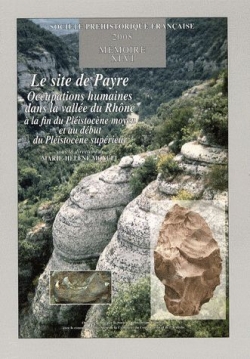
M46 - (2008) Le site de Payre. Occupations humaines dans la vallée du Rhône à la fin du Pléistocène moyen et au début du Pléistocène supérieur - M.-H. MONCEL, dir.
L'ouvrage est toujours disponible en version papier
sous la direction de Marie-Hélène MONCEL Le site de Payre. Occupations humaines dans la vallée du Rhône à la fin du Pléistocène moyen et au début du Pléistocène supérieur, 336 pages
Ouvrage publié par la Société préhistorique française avec le concours du ministère de la Culture et du Conseil général de l'Ardèche (Rhône-Alpes)
Le site de Payre est un gisement de la moyenne vallée du Rhône, daté de la fin du Pléistocène moyen et début du Pléistocène supérieur (fin du MIS 8 au début du 5) selon les analyses radiométriques et paléoenvironnementales. Lors de fouilles qui se sont déroulées de 1990 à 2002, ce gisement a livré une séquence de plusieurs niveaux archéologiques riches en matériel lithique, faunique et en restes humains. L'étude stratigraphique des différentes phases du remplissage permet de constater que les hommes ont occupé une grotte qui s'est effondrée avec le recul du versant. Le gisement est situé en bordure de la rive droite de la vallée du Rhône, en position de promontoire. Des indices d'occupations saisonnières sont fournis par l'analyse des restes fauniques. L'occupation de la cavité par l'ours est indépendante de celles des hommes. Les hommes ont utilisé en priorité du silex, ramassé dans la zone de Rochemaure-Meysse située à 10-20 km au sud, et ponctuellement de la vallée du Rhône. D'autres provenances ont également été mises en évidence, vers le sud, sur des secteurs de 20 à 60 km. Les hommes ont aussi récolté dans la rivière en contrebas des galets de basalte, de quartz et de calcaire pour le façonnage d'outils sur galet. Le quartzite provient du Rhône. Le silex, le quartz et le calcaire ont été débités sur place (silex), sur place ou à l'extérieur (quartz et calcaire). Tout au long de la séquence, une chaîne opératoire de débitage principale de type discoïde sur éclats et blocs de silex et quartz domine trois à cinq chaînes autres opératoires secondaires selon les niveaux. Les petits outils (environ 15 %) sont avant tout en silex et en quartz et sont des racloirs et des outils convergents. Quelques outils sur éclat de grande dimension sont en quartzite, plus rarement en quartz et basalte. De rares outils bifaciaux sur grands éclats de silex ont été découverts ponctuellement à la base de la séquence. Pour toutes les occupations, la forte fragmentation des os, la trace fugace d'une lentille cendreuse dans l'ensemble G, l'usage du feu dans toutes les occupations et la diversité des types d'outils peuvent faire penser à des haltes avec des activités diversifiées lors d'occupations récurrentes saisonnières.
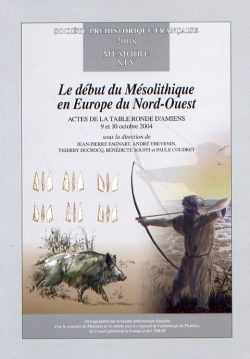
M45PDF - (2008) Le début du Mésolithique en Europe du Nord-Ouest ACTES DE LA TABLE RONDE D'AMIENS 9 et 10 octobre 2004 Sous la direction de JEAN-PIERRE FAGNART, ANDRÉ THEVENIN, THIERRY DUCROCQ, BÉNÉDICTE SOUFFI et PAULE COUDRET
Dix ans après le colloque international d'Amiens, organisé dans le cadre du 119e congrès national des Sociétés historiques et scientifiques, sur le thème Chronostratigraphie et environnement des occupations humaines du Tardiglaciaire et du début de l'Holocène en Europe du Nord- Ouest, la table ronde sur le Mésolithique ancien et moyen de la France septentrionale et des pays limitrophes, qui s'est tenue à Amiens les 9 et 10 octobre 2004, présente l'avancée des recherches menées sur les débuts du Mésolithique des pays riverains de la Manche et de la Mer du Nord méridionale. Cette rencontre s'inscrit dans la série des tables rondes, initiées et organisées par l'un de nous (A.T.) depuis une vingtaine d'années, mais également parmi les manifestations nationales liées à la commémoration du centenaire de la Société préhistorique française (1904- 2004).
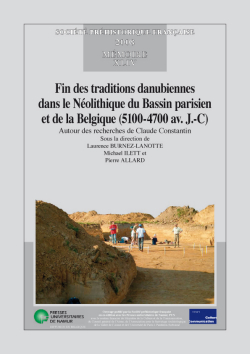
M44 - (2008) Fin des traditions danubiennes dans le Néolithique du Bassin parisien et de la Belgique (5100-4700 av. J.-C.). Autour des recherches de Cl. Constantin - L. BURNEZ-LANOTTE, M. ILETT et P. ALLARD, dir.
L'ouvrage est toujours disponible en version papier
Sous la direction de L. Burnez-Lanotte, M. Ilett et P. Allard (dir.) Fin des traditions danubiennes dans le Néolithique du Bassin parisien et de la Belgique (5100-4700 av. J.-C) Autour des recherches de Claude Constantin, 448 pages
Ouvrage publié par la Société préhistorique française en co-édition avec les Presses universitaires de Namur, PUN
avec le soutien financier du Ministère de la Culture et de la Communication, du Conseil général de l'Aisne, de
l'Association pour le Sauvetage Archéologique de la Vallée de l'Aisne et de l'Université de Paris 1 Panthéon-Sorbonne
Deux objectifs indissociables ont présidé à l'organisation de ce colloque. L'un, rendre un hommage amical à Claude Constantin, l'autre, proposer des échanges sur les recherches récentes à propos de la fin des traditions danubiennes en Bassin parisien et en Belgique, en écho à la thèse soutenue par Claude Constantin en 1983 et aux travaux qu'il a menés depuis. Dans le cadre de la thématique chronologique, géographique et culturelle proposée, les participants ont été invités à travailler de manière spécifique sur les axes de recherches suivants :
- la construction de la séquence chronologique du Rubané et de la culture de Blicquy/Villeneuve-Saint-Germain (BQ/VSG) avec la pratique des sériations des poteries sur base des associations dans des contextes définis, mais aussi, par la mise en perspective des différentes catégories de matériaux (architectures, sépultures, outils, parures, faunes), et ce, dans la diversité des évolutions régionales ;
- L'importance de l'actualité des recherches sur le terrain et celle d'un retour constant aux objets et aux contextes plutôt qu'aux représentations virtuelles
- L'aide de méthodes interdisciplinaires d'observation rigoureuses, la détermination de faits techniques précis, de "détails" liés à des actions concrètes, qui contribuent de manière puissante à l'identification de codes de fabrication ou d'usage à signification culturelle, par exemple dans le cas du dégraissant osseux de la céramique du Limbourg et de la culture de Blicquy/ Villeneuve-Saint-Germain, ou dans celui de la détermination de la provenance des matériaux des anneaux en pierre.
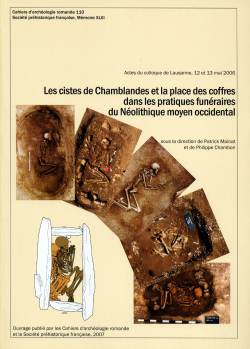
M43 - (2007) Les cistes de Chamblandes et la place des coffres dans les pratiques funéraires du Néolithique moyen occidental (actes du colloque de Lausanne, mai 2006) - P. MOINAT et P. CHAMBON, dir.
Sous la direction de Patrick Moinat et de Philippe Chambon : Les cistes de Chamblandes et la place des coffres dans les pratiques funéraires du Néolithique moyen occidental -Actes du colloque de Lausanne, mai 2006 - 364 pages
M42PDF - (2007) L'épée atlantique : échanges et prestige au Bronze final - Bénédicte QUILLIEC
Télécharger le document
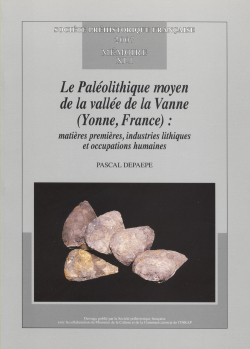
M41 - (2007) Le Paléolithique moyen de la vallée de la Vanne (Yonne, France) Matières premières, industries lithiques et occupations humaines - Pascal Depaepe
Télécharger le document (1ère partie)
Télécharger le document (2ème partie)
Au début des années 1990, quatre gisements du Paléolithique moyen ont été fouillés dans la vallée de la Vanne (Yonne) préalablement à des travaux autoroutiers. Ces fouilles étendues sur plusieurs milliers de m2 ont mis en évidence une vingtaine de sites, datables du Saalien au Pléniglaciaire moyen du Weichselien. Les industries lithiques de ces sites associent à un débitage Levallois dominant, une composante laminaire volumétrique et de rares bifaces ; cet éventail techno-typologique varie selon les périodes considérées.
L'étude pétrographique montre une forte tendance à l'approvisionnement local de proximité immédiate. Quelques rares outils proviennent de sources plus éloignées. Les études spatiales mettent en évidence des sites aux fonctions et statuts différents : habitats de courte durée, habitats plus longuement utilisés, lieux d'activités spécialisées uniques ou variées. Ces données corrélées à la densité des sites suggèrent un modèle d'occupation du territoire de type rayonnant associant sites principaux et sites secondaires interagissant dynamiquement.
Cette étude synthétique des occupations et des industries, menée dans une perspective diachronique et intégrée dans un contexte suprarégional, apporte une contribution remarquable à la connaissance du Paléolithique moyen de la France septentrionale et au-delà.
M40PDF - (2005) D'un monde à l'autre. Les systèmes lithiques pendant le Tardiglaciaire autour de la Méditerranée nord-occidentale. Table Ronde internationale d'Aix-en-Provence, 6-8 juin 2001 - J.-P. BRACCO et C. MONTOYA, dir.
D'un monde à l'autre ... Les actes de la table ronde tenue à Aix-en-Provence en juin 2001 couvrent à la fois la période du Tardiglaciaire et le monde de la Méditerranée occidentale de part et d'autre du Rhône. Le Rhône étant entendu ici comme une limite classique, même si elle reste à discuter finement, entre les cultures magdaléniennes et épipaléolithiques à l'ouest et l'Epigravettien et ses épigones à l'est.
M39 - (2005) Industrie osseuse et parures du Solutréen au Magdalénien en Europe. Table ronde d'Angoulême (Charente), 28-30 mars 2003 - V. DUJARDIN , dir
L'ouvrage est toujours disponible en version papier
V. Dujardin dir. : Industrie osseuse et parures du Solutréen au Magdalénien en Europe, table ronde sur le Paléolithique supérieur récent, Angoulême (Charente, 28-30 mars 2003) - 376 pages.
En mars 2003, une table ronde réunissait à Angoulême une centaine de participants autour de l'industrie osseuse et des parures du Solutréen au Magdalénien en Europe. Deux ans et demi plus tard paraissent les actes de ces très riches travaux présentés à travers vingt-cinq articles qui couvrent essentiellement le Solutréen, le Badegoulien et le Magdalénien sur un vaste territoire allant de l'Espagne à la République tchèque en passant par la France, l'Allemagne, la Suisse et la Roumanie. C'est une vaste panoplie d'industrie osseuse et de parures qui est abordée, reflétant la diversité, les continuités et les ruptures dans l'équipement des chasseurs paléolithiques sur près de dix millénaires.
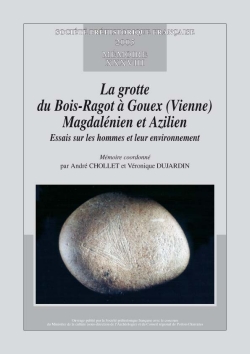
M38 - (2005) La grotte du Bois-Ragot à Gouex (Vienne) Magdalénien et Azilien Essais sur les hommes et leur environnement Mémoire coordonné par André CHOLLET et Véronique DUJARDIN
L'ouvrage est toujours disponible en version papier
La grotte du Bois-Ragot à Gouex (Vienne), découverte en 1968, fut fouillée sous la direction d'André Chollet jusqu'en 1989. Objet d'articles dispersés, elle est souvent citée en référence pour la transition entre le Magdalénien final et l'Azilien. Aujourd'hui, cette monographie, qui rassemble les travaux pluridisciplinaires de 23 auteurs, expose en détail les découvertes faites dans les deux niveaux du Magdalénien final et dans les deux niveaux aziliens, l'un ancien, l'autre récent. Sont ainsi successivement présentés l'historique de la fouille, les industries lithiques, les industries en matières dures animales, les pigments minéraux, les activités graphiques et les parures, les faunes, les restes humains et les nouvelles datations au radiocarbone. Ainsi, l'évolution, les continuités et les ruptures entre les quatre niveaux sont abordées par chaque auteur pour aboutir à un essai de mise en perspective de l'ensemble de ces résultats. Cet ouvrage permettra désormais à ce site d'être une référence sur des bases mieux étayées, en en connaissant les potentiels et les limites.
M37PDF - (2005) La première métallurgie en France et dans les pays limitrophes
La première métallurgie en France et dans les pays limitrophes - Carcassonne, 28-30 septembre 2002, actes du colloque international - 306 pages.
Depuis le manuel de paléométallurgie de Jean-Pierre Mohen, paru en 1990, aucun ouvrage de langue française ne s'était essayé à une synthèse de l'état des connaissances de la première métallurgie (IVe et IIIe millénaires avant J.-C.) de France et des pays limitrophes (Irlande, Allemagne, Italie, Espagne). C'est au terme de la publication de ce colloque, au moins partiellement, chose faite. De surcroît, ces actes, ne sont pas réduits à une succession de textes monographiques, n'ayant aucun lien entre eux. L'internationalisation des recherches dans le district métallurgique de Cabrières-Péret (Sud de la France) depuis une dizaine d'années a induit, au-delà des travaux de terrain et des journées d'études tripartites (France, Allemagne, Espagne), des résultats novateurs (six concernent les sites de Cabrières), mais aussi un croisement des connaissances et des hypothèses de travail entre les acteurs de ces trois pays (notes de C. Strahm et S. Rovira). Ces échanges internationaux ont en outre conduit à la maturation de concepts communs qui se retrouvent, par delà les originalités régionales, dans de nombreux articles. Le but du colloque, et cela transparaît bien dans ces actes, était de proposer le terme actuel de notre réflexion à un large public. S'il convient d'en tirer les enseignements majeurs de ces journées et de ces actes pour des lecteurs non spécialistes qui s'arrêteraient à ce court texte, soulignons que parmi les apports novateurs, en référence au manuel de 1990, il convient de citer : la réduction directe, en une seule étape, de minerais à base de sulfures (à Cabrières, tétra édrite), dans des appareils rudimentaires (photo de couverture) très vraisemblablement largement ouverts, à la seule condition que les sulfures soient mélangés à des minerais oxydés (malachite), selon le processus réalisé expérimentalement par Rostocker, appellé co-smelting ; il convient d'ajouter que l'acquisition de ce point fondamental doit au moins autant au va-et-vient réitéré entre observations archéologiques et archéo-métallurgie expérimentale, qu'aux apports des relations internationales ; l'apparition d'exploitations minières de plus en plus anciennes, suivant des techniques et des modèles dûment établis, dès le IVe millénaire avant J.-C. (Italie). Les exploitations de callais de Gava montrent que, dans des roches relativement tendres, les mineurs avaient déjà rationalisé l'exploitation dès le Ve millénaire ; en. n, soulignons la mobilité des techniques et des échanges de connaissances à l'intérieur du périmètre géographique de ces actes, tout au long du IIIe millénaire avant J.-C. Plusieurs communications de ce colloque (Sangmeister, Strahm, O'Brien, Marinis, Steiniger) en ont tiré un large profit, ouvrant quelques pistes d'avenir.
M36PDF - (2005) Unité et diversité des processus de néolithisation sur la façade atlantique de l'Europe (6e-4e millénaires av. J.-C.). Table ronde de Nantes, 26-27 avril 2002 - G. MARCHAND et A. TRESSET, dir.
Version numérique en accès libre et version papier payante
M35PDF - (2004) Le troisième millénaire dans le Nord de la France et en Belgique Marc Vander Linden et Laure Salanova (dir.)
Actes de la jounée d'études SRBAP - SPF (Lille, 8 mars 2003), numéro spécial de Anthropologica et Praehistorica (ISSN 1377-5723), 115.
2004, 234 pages ISBN : 2-913745-19-9
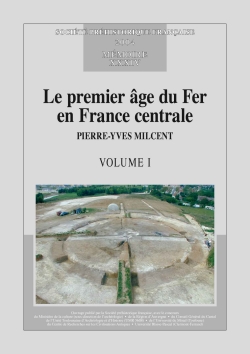
M34PDF - (2004) Le premier âge du Fer en France centrale PIERRE-YVES MILCENT
Notre étude porte sur le premier âge du Fer de l'Auvergne et de la partie orientale des régions Centre et Limousin. Elle repose sur l'inventaire critique de la documentation concernant les découvertes isolées, les habitats, les dépôts et les gisements funéraires. L'objectif est de proposer une nouvelle lecture du premier âge du Fer en France à partir de données actualisées et sans privilégier un faciès de culture plutôt qu'un autre (la France centrale est au carrefour de trois grands domaines culturels). Le plan adopté, de nature chronologique, comprend trois parties. La première est consacrée à la transition Bronze-Fer et au commencement du premier âge du Fer (800-650 av. J.-C.). Les changements apparus au VIIIe s. déterminent le début de la période : réel développement de la métallurgie du fer, transformation des modes d'occupation du sol et des réseaux d'échanges, rupture dans les pratiques de déposition. L'adoption d'un équipement aristocratique d'origine atlantique, dont l'épée hallstattienne, révèle l'ampleur des mutations que subit alors le milieu des élites. Au cours de l'étape moyenne du premier âge du Fer (650-510 av. J.-C.), les femmes acquièrent une forte visibilité et se substituent aux hommes sur le plan archéologique : de riches parures féminines, parfois exotiques, placées dans des sépultures fondatrices, dans des dépôts rituels, en portent témoignage. Le phénomène paraît traduire une recomposition des rôles dans les structures familiales aristocratiques au bénéfice des femmes. L'importance croissante des réseaux d'échanges à longue distance caractérise la fin de la période (510-430 av. J.-C.). L'Allemagne du Sud-Ouest puis l'Italie du Nord influent sur l'évolution des aristocraties dont certains membres adoptent des pratiques funéraires étrangères. L'apparition d'une agglomération urbaine à Bourges est une autre conséquence spectaculaire de ces contacts. La fin du phénomène coïncide avec un processus de standardisation culturelle à l'échelle de l'Europe moyenne.
Our study is about the first Iron Age of Auvergne and the oriental part of the Centre and Limousin regions. It is based on the thorough inventory of the documentation concerning the isolated finds, the settlements, the hoards and the cimeteries. The objective is to propose a new analysis on the first Iron Age in France with new data and without focusing more a cultural profile than another one (Central France is at the junction of three big cultural areas). We have adopted a chronological plan. It include three parts. The first part is about the transition between the Bronze and the Iron Age (800-650 BC). This period starts with the changes that appears on 8th BC : full developement of iron metallurgy, transformation of settlement patterns and exchange networks, break in ritual deposit customs. The use of an aristocratic equipement of atlantic origin ' espacially hallstatt sword' reveals the extent of strong changes in the elite society. During the middle step of the first Iron Age (650-510 BC), we are more documented on women compare with the previous period when men were preeminent. Rich feminin jewels, sometimes exotics, placed in founder burials, in ritual hoards, are the more visible features of this change. It seems to be the sign of an advantageous place for women in the aristocratic families structures. The increasing importance of the long distance exchange networks characterise the end of the first Iron Age (510-430 BC). South-West Germany and Northern Italy have an influence on the elite evolution. Some of their members started to adopt funeral practices from those areas. The urban centre emergence of Bourges is another spectacular consequence of those contacts. The end of this phenomenon coincide with a cultural standardisation process all over Mid-Europe. Traduction Ian Ralston
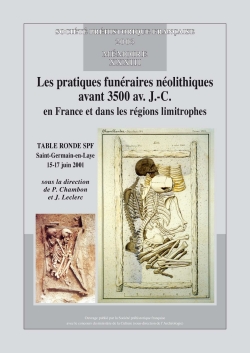
M33PDF - (2003) Les pratiques funéraires néolithiques avant 3500 av. J.-C. en France et dans les régions limitrophes - P. CHAMBON et J. LECLERC, dir
Longtemps quasi inexistantes, nos connaissances sur les pratiques funéraires des premières périodes du Néolithique français ont connu depuis deux décennies un développement spectaculaire. Nous disposons maintenant dans beaucoup de régions de petits groupes de sépultures, voire de véritables nécropoles. Pourtant, ces pratiques continuent à n'être abordées qu'occasionnellement, lors de réunions d'actualité ou de colloques sur des thèmes plus généraux. La Société préhistorique française a considéré que le temps était venu d'établir un premier bilan ; elle a proposé aux chercheurs concernés de se réunir à Saint-Germain-en-Laye du 15 au 17 juin 2001 pour des journées d'échanges et de réflexion collective partant de l'interprétation des documents de terrain. C'est un aspect essentiel de la néolithisation de notre pays qu'il s'agissait ainsi de mettre en lumière. Le présent ouvrage réunit les textes issus de ces journées dans l'ordre thématique qui a été celui de la réunion, chaque série de présentations étant suivie par le texte à peine abrégé de la discussion qui la concluait. Partant de l'observation des restes humains eux-mêmes pour les intégrer progressivement dans l'ensemble des éléments du site, il présente d'abord des études sur le corps, le mobilier, et les conditions du dépôt ; il aborde ensuite l'identification des structures sépulcrales et des modes d'enfouissement, avant de prendre en considération l'organisation d???ensemble des sites funéraires (en particulier, la place de l'espace sépulcral dans l'ensemble funéraire). Enfin, la dernière partie de l'ouvrage, cherchant à reconnaître les types fonctionnels de sépultures, donne l'occasion de prendre en compte l'ensemble des composantes de chaque type pour en chercher l'unité et la logique dans une approche intégrée et structurale de la pratique funéraire.
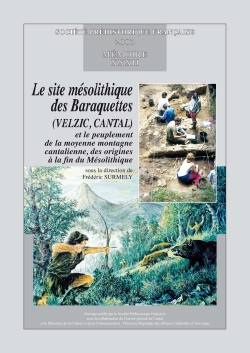
M32 - (2003) Le site mésolithique des Baraquettes (Velzic, Cantal) et le peuplement de la moyenne montagne cantalienne, des origines à la fin du Mésolithique - Fr. SURMELY, dir.
Version numérique en accès libre et version papier payante
L'ouvrage est toujours disponible en version papier
L'ouvrage dresse le bilan des recherches menées de 1992 à 2000 sur la question du peuplement préhistorique du massif cantalien, des origines (Magdalénien) à la fin du Mésolithique. Fouilles, prospections, études de séries anciennes, inventaire et caractérisation des gîtes à silex, études paléoenvironnementales, menées par une équipe pluridisciplinaire, ont permis de proposer un autre schéma de la conquête de cette terre de moyenne altitude. A l'évidence, le peuplement a été le fait de communautés humaines bien organisées sur le plan spatial et social, qui ont été attirées par les ressources diversifiées offertes par les territoires d'altitude. La circulation de matières premières sur de longues distances témoigne de contacts avec les régions voisines. Le site des Baraquettes, dont la présentation occupe près de la moitié de la publication, a livré une séquence d'occupations du Mésolithique ancien et du Mésolithique moyen, qui constitue une référence pour la connaissance de ces cultures dans le Massif central.
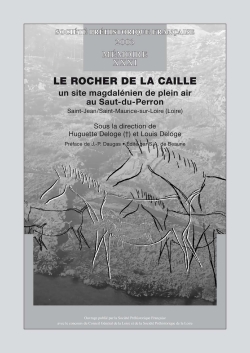
M31 - (2003) Le Rocher de la Caille : un site magdalénien de plein air au Saut du Perron (Loire) - H. DELOGE et L. DELOGE, dir.
Version numérique en accès libre et version papier payante
Cet ouvrage publie quinze études scientifiques faites à partir des fouilles effectuées sur le site magdalénien du Rocher de la Caille. Ce site était l'un des quatre gisements paléolithiques au lieu-dit"Le Saut du Perron " qui ont été fouillés avant la mise en eau du barrage de Villerest sur la Loire. La fouille a été réalisée de 1979 à 1983 par Huguette Deloge et Louis Deloge, avec la collaboration de nombreux spécialistes des diverses disciplines de l'archéologie préhistorique. Le remplissage renfermait des vestiges attribuables au Magdalénien supérieur avec, en particulier, des schistes gravés, des godets en stéatite et des lampes. Cet ouvrage constitue la monographie très complète d???un des rares sites magdaléniens du Centre de la France. Il est abondamment documenté et illustré.
M30PDF - (2002) Solutré 1968-1998 - J. COMBIER et A. MONTET-WHITE, dir
J. Combier et A. Montet-White - Solutré 1968 - 1998 - 281 pages
M29 - (2002) LAurignacien entre mer et océan. Réflexion sur lunité des phases anciennes de lAurignacien dans le Sud de la France - F. BON
L'ouvrage est toujours disponible en version papier
F. Bon - L'Aurignacien entre Mer et Océan : réflexion sur l'unité des phases anciennes de l'Aurignacien dans le sud de la France - 253 pages
La définition de l'Aurignacien est au coeur d'une des questions majeures de la Préhistoire européenne, qui est celle de la transition entre le Paléolithique moyen et le Paléolithique supérieur. Cette culture atteste en effet des changements sur lesquels les recherches se fondent pour établir la distinction entre ces deux grandes périodes. Le problème demeure de savoir où, quand et comment s'est déroulé ce processus, qui a conduit à l'avènement de l'Aurignacien. Cette culture correspond t-elle à l'arrivée de populations venant de régions extérieures à l'Europe occidentale ? Si tel est le cas, s'agit-il d'une ou de plusieurs vagues de peuplement ? Quelle est l'unité de cette culture dans le temps et dans l'espace ?
M28 - (2000) Le Paléolithique supérieur récent - G. PION
Description : L'ouvrage est toujours disponible en version papier
D. Drucker, H. Bocherens, A. Mariotti, Contribution de la biogéochimie isotopique à l'étude de la paléobiologie des grands mammifères du Pléistocène supérieur : application aux rennes et aux chevaux magdaléniens et solutréens du Sud-Ouest de la France ; C. Bémilli, Nouvelles données sur les faunes aziliennes du closeau, Rueil-Malmaison (Hauts-de-Seine) ; J. G. Enloe, Le Magdalénien du Bassin parisien au Tardiglaciaire : la chasse aux rennes comparée à celle d'autres espèces ; A. Bridault, L. Chaix, G. Pion, C. Oberlin, S. Thiébault, J. Argant, Position chronologique du renne (Rangifer tarandus L.) à la fin du Tardiglaciaire dans les Alpes du Nord françaises et le Jura méridional ; L. Fontana, Stratégies de subsistance au Badegoulien et au Magdalénien en Auvergne : nouvelles données ; A. Thévenin, Géographie et cultures au Tardiglaciaire, l'impact de l'axe Rhône-Saône ; M. Lenoir, La fin des temps glaciaires dans les basses vallées de la Dordogne et de la Garonne ; M. Otte, L »'adaptation aux plaines du Nord au Paléolithique final ; F. Djindjian, Identité, chronologie et territoires du Magdalénien en Europe occidentale : questions posées ; J.-P. Fagnart, P. Coudret, Données récentes sur le tardiglaciaire du bassin de la Somme ; F. Bazile, C. Monnet-Bazile, Le Magdalénien et l'après-Magdalénien en Languedoc oriental ; G. Pion, Le Magdalénien des deux Savoie et du Jura méridional : synthèse préliminaire des données accessibles, proposition d'une chronologie pour les principaux gisements ; F. Surmely, Le peuplement magdalénien de l'Auvergne ; J. Bullinger, L'industrie lithique du site magdalénien de Monruz (Neuchâtel, Suisse) et les ensembles contemporains de l'arc jurassien ; D. Chaffotte, A. Thévenin, Nouveaux éléments du Paléolithique supérieur final et de l'Epipaléolithique en vallée de Saône ; E. Ladier, Le Magdalénien ancien à lamelles à dos de l'abri Gandil à Bruniquel (Tarn-et-Garonne) : étude préliminaire de l'industrie lithique de la C20 ; A.-C. Welté, Le Magdalénien supérieur et les propulseurs dans la vallée de l'Aveyron : révision chronologique ; V. Dujardin, G. Pinçon, Le Magdalénien dans la Vienne et dans la Charente ; S. Soriano, H. Lechenet, Des « Orvilles » en Bourgogne, l'occupation du site de la Roncière (Bèze, Côte-d'Or) au Paléolithique supérieur ; M. Cartonnet, H.-G. Naton, Le Magdalénien de la grotte de la Chênelaz à Hostias (Ain) ; B. Bosselin, G. Pion, La Fru, « Gerbaix Dessus » et Saint-Thibaud-de-Couz (Savoie) : les industries lithiques dans leur cadre chronoclimatique et industriel ; B. Valentin, L'usage des percuteurs en pierre tendre pour le débitage des lames, circonstances de quelques innovations au cours du Tardiglaciaire dans le bassin parisien ; P. Bintz, Origine et circulation des matières premières siliceuses dans les Alpes du Nord : exemple de trois sites du Paléolithique final ; G. Monnin, Apport de la technologie lithique à l'étude des séries anciennes, Les assemblages tardiglaciaires des chasseurs de marmottes des grottes Colomb et de la Passagère à Méaudre (Vercors, Isère).
M27PDF - (2000) La question du Campaniforme en France et dans les îles Anglo-Normandes Productions, chronologie et rôles d'un standard céramique Laure Salanova
2000, Paris : CTHS et SPF, in 4o broché, 391 pages, ISBN : 2-7355-0443-3
M26PDF - (2000) 14C et archéologie : 3e congrès international 14C and archaeology: 3rd international symposium Lyon, 6-10 avril 1998 Jacques Évin (dir.)
Cet ouvrage publie 72 communications, conférences et rapports de groupes de travail, présentés lors du 3e Congrès international « Radiocarbonne et Archéologie », tenu à Lyon du 6 au 10 avril 1998.
Ces textes se regroupent suivant cinq thèmes couvrant les principaux aspects de l'application du radiocarbonne à l'archéologie depuis le Paléolithique supérieur jusqu'au Moyen Âge :
-les matériaux de datation ;
- la « calibration », c'est-à-dire l'ajustement des dates 14C au calendrier en années av. ou apr. J.-C. ;
- l'apport du radiocarbonne à la résolution de questions importantes en archéologie, comme la néolithisation, l'apparition de l'homme moderne ou de la métallurgie ;
- les synthèses de l'ensemble des datations 14C disponibles pour diverses parties du monde (Europe, Asie, Amérique du Sud, Afrique) ;
- la chronologie précise de certaines phases culturelles néolithiques ou médiévales.
En chacun de ces domaines des contributions des laboratoires de radiocarbonne de toutes les régions du monde font état des dernières données acquises tant en méthodologie que par l'accumulation d'un grand nombre de résultats.
1999, in 4o broché, 478 pages, ISBN : 2-913745-02-4
M25PDF - (1999) Les enceintes néolithiques de Diconche à Saintes (Charente-Maritime) Une périodisation de l'Artenac Claude Burnez et Pierrick Fouéré (dir.)
Télécharger le document (volume 1)
Télécharger le document (volume 2)
1999, Paris : SPF et Chauvigny : Association des publications chauvinoises (Mémoire 15), in 4o broché, 2 vol., 829 pages - ISBN : 2-909165-30-2 (APC)
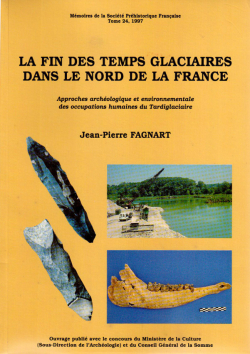
M24 - (1997) La fin des temps glaciaires dans le Nord de la France - J.-P. FAGNART
M23 - (1996) Fouilles de Pincevent II - G. GAUCHER
M22 - (1995) Les derniers chasseurs de rennes du monde pyrénéen. Labri Dufaure : un gisement tardiglaciaire en Gascogne - L.-G. STRAUS, dir.
Étude pluridisciplinaire du gisement magdalénien et Azilien (Sorde-l'Abbaye, Landes).
M21 - (1989) Le gisement paléolithique moyen de Biache-Saint-Vaast (Pas-de-Calais) - A. TUFFREAU et J. SOMME
M20 - (1988) Une habitation magdalénienne dÉtiolles - M. OLIVE
M19 - (1988) La grotte Vaufrey, Dordogne - J.-P. RIGAUD
J.-Ph. Rigaud : La Grotte Vaufrey, Dordogne (1988) - 616 pages
M18 - (1984) Structures dhabitat et fortifications de lÂge du Fer en France septentrionale - O. BUCHSENSCHUTZ
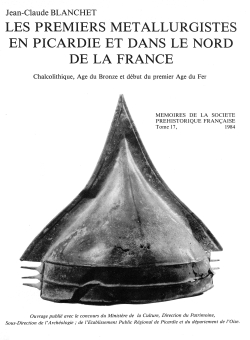
M17PDF - (1984) Les premiers métallurgistes en Picardie et dans le Nord de la France Chalcolithique, âge du Bronze et début du premier âge du Fer Jean-Claude Blanchet
1984, in 4o broché, 608 pages - 1984, in 4o broché, 608 pages
M16 - (1983) La faune et lhomme préhistoriques, dix études en hommage à J. Bouchud - F. POPLIN
L'ouvrage est toujours disponible en version papier
M15 - (1981) Le Piage, site préhistorique du Lot - F. CHAMPAGNE et R. ESPITALIE
F. Champagne et R. Espitalié : Le Piage, site préhistorique du Lot (1981), 288 pages
M14 - (1980) LÂge du fer en Aquitaine - J.-P. MOHEN
M13 - (1978) Le gisement préhistorique de Duruthy à Sordes-lAbbaye, Landes - R. ARAMBOUROUCollection Mémoires
M12 - (1976) Le Néolithique et le Chalcolithique dans le Centre-Ouest de la France - C. BURNEZ
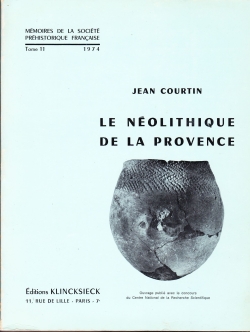
M11PDF - (1974) Le Néolithique de la Provence Jean Courtin
L'ouvrage présente le cadre naturel et les ressources, et étudie les objets métalliques et lithiques, l'industrie en os, la céramique, la parure, les rites funéraires, les nécropoles, l'anthropologie, les habitats et la vie économique et sociale. Il comporte un inventaire des sites.
1974, in 4o broché, 359 pages
M10- (1972) LÂge du bronze en Languedoc oriental - J.-L. ROUDIL
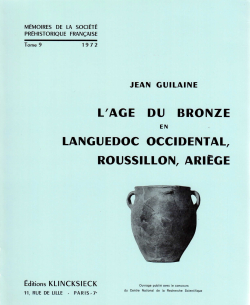
M09 - (1972) L'Âge du bronze en Languedoc occidental, Roussillon, Ariège - J. GUILAINE
J. Guilaine : L'Âge du Bronze en Languedoc Occidental, Roussillon, Ariège (1972), 460 pages
M08 - (1970) Le site protohistorique de Gours-aux-Lions, Seine-et-Marne - C. et D. MORDANT
C. et D. Mordant : Le site protohistorique de Gours-aux-Lions, Seine et Marne (1970) - 140 pages
L'ouvrage est toujours disponible en version papier
M07 - (1969) Une cabane acheuléenne dans la grotte du Lazaret, Nice - H. de LUMLEY
Collection Mémoires
M07 - (1969) Une cabane acheuléenne dans la grotte du Lazaret, Nice - H. de LUMLEY
Telechargement
en accès libre
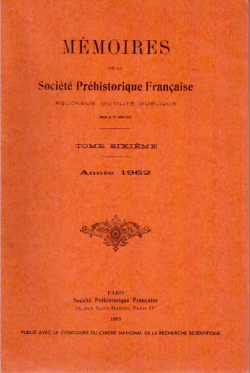
M06 - (1962) Le Cirque de la Patrie - Dr CHEYNIER
L'ouvrage est toujours disponible en version papier
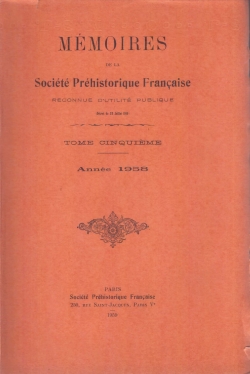
M05 - (1958) Textes divers de 9 auteurs
M05 - (1958) Textes divers de 9 auteurs
L'ouvrage est toujours disponible en version papier
A. et J. Bouyssonie, et P. Férol, Le gisement moustérien de « Chez-Pourré, Chez-Comte » (près Brice, Corrèze), p. 1-60
J. Combier, E. Drouot et P. Huchard, Les grottes solutréennes à gravures pariétales du Cayon inférieur de l'Ardèche, p. 61-117
M. Escalon de Fonton, Quelques civilisations méditerranéennes du Paléolithique supérieur au Mésolithique, p. 118-134
A. Glory, Débris de corde paléolithique à la grotte de Lascaux (Dordogne), p. 135-169
L. Pradel, La grotte magdalénienne de la Marche, commune de Lussac-les-Châteaux (Vienne), p. 170-191
G. Bailloud, L'habitat néolithique et protohistorique des Roches, commune de Videlles (Seine-et-Oise), p. 192-214
T. Poulain-Josien, Videlles (Seine-et-Oise). Étude de la faune, p. 215-232
J. Audibert, Les civilisations chalcolithiques du Gard, p. 233-305
G. Gaudron, Postface, p. 306-307.
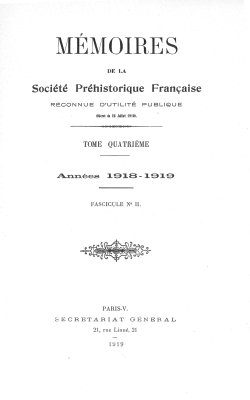
M04PDF - (1918-1919) Tome 4
Télécharger le document (1ère partie)
Télécharger le document (2ème partie)
Tome quatrième, Fascicule no I, Années 1915-1918 (1918)
M. Baudoin, Fouille, restauration et description de l'allée couvertee des Pierres-Folles des Cous et de ses menhirs indicateurs, à Bazoges-en-Pares (Vendée), p. 1-59
E. Hue, Des molaires des Équidés, p. 61-96
P. Trassagnas, Découvertes d'une nécropole gallo-romaine à puits funéraires à Tours-sur-Marne (Marne), p. 97-137
Dr. Jousset de Bellesme, Les terrains quaternaires du Perche et leurs industries, p.139-167.
Tome quatrième Fascicule no II, Années 1918-1919 (1919)
L. Coutil, L'allée couverte de Vaudancourt (Oise), p. 1-28
M. Baudouin, Remarques sur l'architectonique de l'allée couverte de Vaudancourt (Oise), p. 29-51
M. Baudouin, Les ossements de l'allée couverte de Vaudancourt (Oise), p. 52-141
M. Baudouin, La pathologie des ossements de l'allée couverte de Vaudancourt (Oise), p. 142-149
M. Baudouin, Les atlas et axis de l'allée couverte de Vaudancourt (Oise). Étude anatomique, p. 150-169.
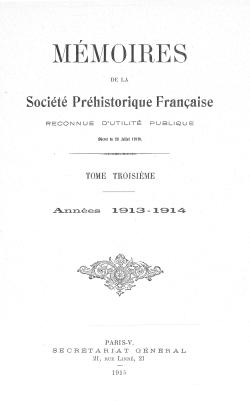
M03PDF - (1913-1914) Tome 3
Tome troisième - Années 1913-1914 (1915)
L. Rousseau et M. Baudoin, L'ossuaire de la ciste sous tumulus-glagal des Cous, à Bazoges-en-Pareds (Vendée). Découverte, fouille et restauration, p. 1-91
Dr. Ballet, à propos des éolithes du Puy-Courny, p. 92-104
M. Baudoin, Le rocher aux pieds du mas d'Ile, à Lessac (Charente), p. 105-162
L. Coutil, Casques antiques (Proto-Étrusques, Mycéniens, Illyriens, Grecs, Gaulois et Romains), p. 163-225.
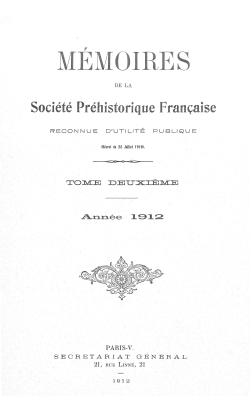
M02PDF - (1912) Tome 2
Tome deuxième, Année 1912 (1912)
A. Guébhard, Sur l'anse funiculaire, p. 1-184
A. Terrade, Le « burin-ciseau » de la station moustérienne de Catigny (Oise), p. 185-195
E. Hue, L'âge de la Pierre au Fouta-Djalon. Collection de M. le comte Paul Guébhard, p. 196-263
Dr Ferrier, Les dents humaines de la sépulture néolithique de Belleville, à Vandrest (Seine-et-Marne). 1er mémoire : les dents de première dentition, p. 264-279
M. Baudouin et E. Hue, Découverte et étude d'une cachette de fondeur de bronze de la seconde époque du Fer, à Saint-Pierre-de-Maillé (Vienne), p. 280-294
J. Pagès-Allary, Fouilles de Chastel-sur-Murat, p. 295-315.

M01PDF - (1911) Tome premier
Marcel Baudoin (Paris). Les Haches plates en Vendée 1-113
O. Desmazières (Ségré, M-et-L.). Les Haches plates et l'Origine de l'Industrie Préhistorique du Cuivre dans le département de Maine-et-Loire 114-133
Th. Baudon (Beauvais, O.). Le Préhistorique sur la Falaise du Thelle. - Recherche de l'Homme tertiaire. Industrie pré-pléistocène 135-192
L. Coutil (Saint-Pierre-du-Vouvray, E.). Le Casque d'or d'Amfreville-sous-les-Monts et le Casque en fer de Notre-Dame-de-Vaudreuil (Eure) - Etude comparative des Casques Gaulois 193-207
E. Boismoreau (Saint-Mesmin-le-Vieux, V.). Découverte et Etude du souterrain refuge des Vergnauderies, près la Mautruère, Commune de Montournais (Vendée) 209-223
Coordonnées
Pôle éditorial de la MSH Mondes
(Maison de l'archéologie et de l'éthnologie)
Boite 41
21 allée de l'Université
F-92023 Nanterre cedex - FRANCE
Société préhistorique française
- La SPF
- Réunions
- Le Bulletin de la SPF
- Organisation et comité de rédaction
- Comité de lecture (2020-2025)
- Ligne éditoriale et consignes BSPF
- Données supplémentaires
- Annoncer dans le Bulletin de la SPF
- Séances de la SPF (suppléments)
- Bulletin de la SPF 2025, tome 122
- Bulletin de la SPF 2024, tome 121
- Bulletin de la SPF 2023, tome 120
- Bulletin de la SPF 2022, tome 119
- Archives BSPF 1904-2021 en accès libre
- Publications
- Newsletter
- Boutique
Powered by aiw-pro | all-in-web © 2025 | Simplifiez-vous la vie!
Chargement de la page : 1285 ms

